Jim Shooter's Blog, page 8
October 25, 2011
SUPERMAN – First Marvel Issue – Byrne's Plot
JayJay here. Jim wrote, in a previous blog entry, about the time in 1984 when Marvel Comics was negotiating with DC to publish Superman comics among others. Read that original entry here. John Byrne had submitted a plot to Jim for the first Marvel issue of Superman. Many of our readers have been curious about that plot, so as he promised last week, here is more information.

It Isn't Fair…
…to show the actual plot here. Sorry if you're disappointed. Though he gave me a copy (in 1984), it's Byrne's story. Maybe he'll publish it.
Doesn't mean I can't tell you the tale in my own words, as faithfully as possible.
The Story
The first chapter is entitled "KRYPTON."
As in the classic origin, scientist Jor-El has discovered that his world, the planet Krypton is going to explode sometime soon.
Could be today, any day, but surely within a month.
Jor-El is a member of Krypton's ruling "Council of Twelve." Warning tremors shake the Council room, but the other members refuse to believe the danger is real. Jor-El is angry. Let them all die, then!
At home, Jor-El talks things over with his wife, Lara, who is six months pregnant. He has a plan to save her and their unborn child, at least, to which she tearfully agrees.
He was hoping that a large spacecraft might be built, big enough to save a "major portion" of the population, but time has run out. He has built a small "model" of the big ship he proposed, just large enough to hold one adult. He intended to pilot it himself on a "test flight," but forget that. The untested little ship must carry Lara off world and safely away from Krypton's catastrophic demise. There is no other way.
Jor-El makes preparations with frantic haste. As Krypton is rocked by its violent death throes, Jor-El and Lara say their last good-byes.
The launch must be timed perfectly.
Jor-El knows that Lara and fetus will become super-powerful as they are affected by the rays of the yellow sun where they're headed. He also knows of an "additional factor" as well that will help them survive on the world that is their destination. Timing of the launch is critical to this mysterious factor.
At the perfect moment, Jor-El waves to Lara in the little ship and launches the rocket. Lara looks back at dying Krypton—which explodes, sending forth a burst of "searing radiation"—the mysterious, additional factor, maybe? John doesn't say. Lara feels the radiation affecting her just before the rocket enters hyper space.
The hyper-light-speed journey takes three months.
The second chapter is entitled "SMALLVILLE."
Earth, the USA, somewhere out in the sticks, fifty-something Jonathan and Martha Kent are riding along in their pickup truck. They're farm people, good people. They witness the little ship launched months ago by Jor-El crash in a field.
They run to investigate.
Jonathan pulls badly-injured Lara from the wreckage. Right then and there, with the Kents' help, she gives birth. The child, a boy, yelps when Jonathan slaps him on the butt. He seems unharmed and healthy. Just before she dies, Lara names the boy Kal-El.
The childless Kents decide to keep the baby as their own. They name him Clark.
They successfully convince friends and neighbors that 50-some-year-old Martha had been pregnant, but they'd kept it secret.
No mention of what became of the wreckage of the ship or Lara's body.
At the age of two, at Clark's birthday party we are introduced to the Langs, friends of the Kents, and their infant daughter Lana.
Clark begins to demonstrate fantastic strength, but only the Kents see.
At age ten, Clark is attacked by a bull while crossing a pasture. The bull does its best to kill him, but cannot harm Clark. His clothes are not so lucky. They're shredded. Clark flips the 1,000 pound bull over his head, then runs home to tell mom and dad about the event. The bull, by the way, is okay.
Jonathan and Martha caution Clark to keep these things he can do secret, lest government or military people find out and come to take him away for who knows what purposes.
At age fifteen, while playing with his dog, Clark discovers he can defy gravity. The dog playfully leaps at him, knocking him backward a few steps. Instead of falling into the drainage ditch behind him, though, Clark finds himself hovering over it. After a little practice, he learns to fly.
Meanwhile, Jonathan (in his late sixties at this point) is trying, with two other men, to physically pull a tractor out of some mud it's stuck in. The exertion triggers a heart attack and Jonathan dies.
The third chapter is entitled "METROPOLIS."
Years later, after graduating at the top of his class from "journalism school," Clark is hired as a reporter by Perry White, Editor in Chief of the Daily Planet in Metropolis. He meets "brash" Jimmy Olsen, a cub reporter, and Lois Lane. Byrne describes her as "…beautiful, but in a city-slick, used sort of way, tousled and vaguely rough at the edges." She's the type who would curse a lot. Clark is "instantly infatuated." She welcomes Clark.
Lois and Clark, both superb reporters, become not-so-friendly rivals, despite Clark's infatuation. He allows her to win, to get the story first sometimes.
Perry White urges Clark to try harder. Women and children first is for lifeboats (or little rockets, I suppose). White somehow knows a big story is about to break and tells Clark to go get it.
The next day the President is taken captive by terrorists. Lois investigates by traditional means. Clark surreptitiously uses his super powers to locate the farmhouse where the President is being held and alerts the authorities. They storm the place. Five people die in the raid and the President is gravely injured.
Clark realizes that if he'd handled it himself, he could have saved the President without any loss of life. The little light bulb goes on….
He talks it over with his adoptive mother, Martha. They agree that he should stop hiding his powers and use them for good. To protect those close to him he has to keep it secret that he, Clark, is the hero he now means to become.
When he was a kid, Martha made him wear glasses he didn't need to make him "more human." (?) He'll start wearing glasses again to help disguise himself when he's Clark Kent. A point of difference from his hero self.
Martha, anticipating this day, long ago bought red, blue and yellow cloth from which to make a costume.
Apparently, as Clark aged, he developed…something…an "aura," perhaps, that more and more protected his clothing when he did super things. So, she will make him a skin-tight uniform to take best possible advantage of that.
The fourth chapter is entitled "THE MAN OF TOMORROW."
Sometime later, a caped, costumed figure breaks up an armored car robbery and frees hostages. Bullets bounce harmlessly off of his chest. He turns the miscreants over to police and flies away.
The caped man spectacularly rescues a stuck tramway car.
Then he pulls subway cars full of people from a collapsed tunnel. Lois Lane is there, reporting. She reaches the caped man before he can fly away. She doesn't recognize him as Clark.
She is as attracted to this caped hero as Clark was to her.
Lois wants to tell this mysterious hero's story. She asks him questions, which he answers. This will be her greatest coup ever as a reporter. Sorry, the caped man says, he's already given his story to someone else, Clark Kent. He flies away.
Elsewhere, later, a shadowy figure watches television news accounts of the exploits of the caped man. He reads the Daily Planet article by Clark Kent, which has the bold headline: "SUPERMAN! MYSTERY HERO PROMISES TO BATTLE FOR TRUTH, JUSTICE AND THE AMERICAN WAY.
The shadowy figure is criminal mastermind Lex Luthor, who decides that he's going to have to get rid of this Superman.
FIN
Combat Pay, Quota Fulfillment
Here are a couple of memos from way back that address issues of creator compensation brought up in the comments: [image error]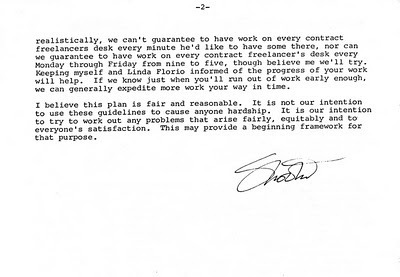
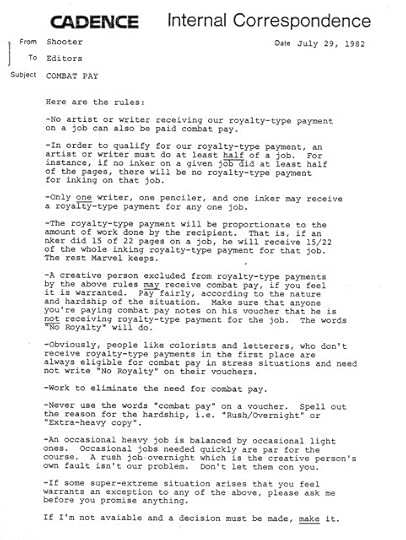

NEXT: More Tales to Astonish

It Isn't Fair…
…to show the actual plot here. Sorry if you're disappointed. Though he gave me a copy (in 1984), it's Byrne's story. Maybe he'll publish it.
Doesn't mean I can't tell you the tale in my own words, as faithfully as possible.
The Story
The first chapter is entitled "KRYPTON."
As in the classic origin, scientist Jor-El has discovered that his world, the planet Krypton is going to explode sometime soon.
Could be today, any day, but surely within a month.
Jor-El is a member of Krypton's ruling "Council of Twelve." Warning tremors shake the Council room, but the other members refuse to believe the danger is real. Jor-El is angry. Let them all die, then!
At home, Jor-El talks things over with his wife, Lara, who is six months pregnant. He has a plan to save her and their unborn child, at least, to which she tearfully agrees.
He was hoping that a large spacecraft might be built, big enough to save a "major portion" of the population, but time has run out. He has built a small "model" of the big ship he proposed, just large enough to hold one adult. He intended to pilot it himself on a "test flight," but forget that. The untested little ship must carry Lara off world and safely away from Krypton's catastrophic demise. There is no other way.
Jor-El makes preparations with frantic haste. As Krypton is rocked by its violent death throes, Jor-El and Lara say their last good-byes.
The launch must be timed perfectly.
Jor-El knows that Lara and fetus will become super-powerful as they are affected by the rays of the yellow sun where they're headed. He also knows of an "additional factor" as well that will help them survive on the world that is their destination. Timing of the launch is critical to this mysterious factor.
At the perfect moment, Jor-El waves to Lara in the little ship and launches the rocket. Lara looks back at dying Krypton—which explodes, sending forth a burst of "searing radiation"—the mysterious, additional factor, maybe? John doesn't say. Lara feels the radiation affecting her just before the rocket enters hyper space.
The hyper-light-speed journey takes three months.
The second chapter is entitled "SMALLVILLE."
Earth, the USA, somewhere out in the sticks, fifty-something Jonathan and Martha Kent are riding along in their pickup truck. They're farm people, good people. They witness the little ship launched months ago by Jor-El crash in a field.
They run to investigate.
Jonathan pulls badly-injured Lara from the wreckage. Right then and there, with the Kents' help, she gives birth. The child, a boy, yelps when Jonathan slaps him on the butt. He seems unharmed and healthy. Just before she dies, Lara names the boy Kal-El.
The childless Kents decide to keep the baby as their own. They name him Clark.
They successfully convince friends and neighbors that 50-some-year-old Martha had been pregnant, but they'd kept it secret.
No mention of what became of the wreckage of the ship or Lara's body.
At the age of two, at Clark's birthday party we are introduced to the Langs, friends of the Kents, and their infant daughter Lana.
Clark begins to demonstrate fantastic strength, but only the Kents see.
At age ten, Clark is attacked by a bull while crossing a pasture. The bull does its best to kill him, but cannot harm Clark. His clothes are not so lucky. They're shredded. Clark flips the 1,000 pound bull over his head, then runs home to tell mom and dad about the event. The bull, by the way, is okay.
Jonathan and Martha caution Clark to keep these things he can do secret, lest government or military people find out and come to take him away for who knows what purposes.
At age fifteen, while playing with his dog, Clark discovers he can defy gravity. The dog playfully leaps at him, knocking him backward a few steps. Instead of falling into the drainage ditch behind him, though, Clark finds himself hovering over it. After a little practice, he learns to fly.
Meanwhile, Jonathan (in his late sixties at this point) is trying, with two other men, to physically pull a tractor out of some mud it's stuck in. The exertion triggers a heart attack and Jonathan dies.
The third chapter is entitled "METROPOLIS."
Years later, after graduating at the top of his class from "journalism school," Clark is hired as a reporter by Perry White, Editor in Chief of the Daily Planet in Metropolis. He meets "brash" Jimmy Olsen, a cub reporter, and Lois Lane. Byrne describes her as "…beautiful, but in a city-slick, used sort of way, tousled and vaguely rough at the edges." She's the type who would curse a lot. Clark is "instantly infatuated." She welcomes Clark.
Lois and Clark, both superb reporters, become not-so-friendly rivals, despite Clark's infatuation. He allows her to win, to get the story first sometimes.
Perry White urges Clark to try harder. Women and children first is for lifeboats (or little rockets, I suppose). White somehow knows a big story is about to break and tells Clark to go get it.
The next day the President is taken captive by terrorists. Lois investigates by traditional means. Clark surreptitiously uses his super powers to locate the farmhouse where the President is being held and alerts the authorities. They storm the place. Five people die in the raid and the President is gravely injured.
Clark realizes that if he'd handled it himself, he could have saved the President without any loss of life. The little light bulb goes on….
He talks it over with his adoptive mother, Martha. They agree that he should stop hiding his powers and use them for good. To protect those close to him he has to keep it secret that he, Clark, is the hero he now means to become.
When he was a kid, Martha made him wear glasses he didn't need to make him "more human." (?) He'll start wearing glasses again to help disguise himself when he's Clark Kent. A point of difference from his hero self.
Martha, anticipating this day, long ago bought red, blue and yellow cloth from which to make a costume.
Apparently, as Clark aged, he developed…something…an "aura," perhaps, that more and more protected his clothing when he did super things. So, she will make him a skin-tight uniform to take best possible advantage of that.
The fourth chapter is entitled "THE MAN OF TOMORROW."
Sometime later, a caped, costumed figure breaks up an armored car robbery and frees hostages. Bullets bounce harmlessly off of his chest. He turns the miscreants over to police and flies away.
The caped man spectacularly rescues a stuck tramway car.
Then he pulls subway cars full of people from a collapsed tunnel. Lois Lane is there, reporting. She reaches the caped man before he can fly away. She doesn't recognize him as Clark.
She is as attracted to this caped hero as Clark was to her.
Lois wants to tell this mysterious hero's story. She asks him questions, which he answers. This will be her greatest coup ever as a reporter. Sorry, the caped man says, he's already given his story to someone else, Clark Kent. He flies away.
Elsewhere, later, a shadowy figure watches television news accounts of the exploits of the caped man. He reads the Daily Planet article by Clark Kent, which has the bold headline: "SUPERMAN! MYSTERY HERO PROMISES TO BATTLE FOR TRUTH, JUSTICE AND THE AMERICAN WAY.
The shadowy figure is criminal mastermind Lex Luthor, who decides that he's going to have to get rid of this Superman.
FIN
Combat Pay, Quota Fulfillment
Here are a couple of memos from way back that address issues of creator compensation brought up in the comments: [image error]



NEXT: More Tales to Astonish
Published on October 25, 2011 13:58
Uncanny Divinations and Premonitions
First This
This is the post that I meant to have up Saturday. Tomorrow's will be today's. You know what I mean. Sorry.
Stellar Horoscope
Early on during my time at Marvel, at a convention in New York City, I met a comics fan who was a part-time astrologer. He had a regular day job, some bookkeeping or accounting-type thing, but on the side, he did horoscopes. He liked what I had to say at some panel I was on, thought I seemed like an interesting subject and volunteered to do my chart. Free. Okay. I gave him my date and time of birth and the city where I was born.
A couple of weeks later, he stopped by the Marvel offices to deliver his work, a hand-drawn astrological chart and his analysis of same.
The chart was beautiful. Framable. I still have it, packed away somewhere in the storage space.
The analysis?
What he came up with was startling. His analysis detailed things about me that nobody knew but people very close to me, and a few things that only I knew. Things that, I assure you, would have been nigh impossible to find out.
Like what? Well, he knew that I almost died shortly after being born. Something to do with blood, he supposed. Yes, because of Rh factor problems, I needed seven complete transfusions in the first three days of my life. One of my parents' neighbors, one Adam Corcoran, donated the blood that saved my life.
The astrologer knew many other things about my family and childhood that spooked me out.
Did he fly to Pittsburgh and check the records at Mercy Hospital? Did he call and interview my mother and my sister?
Mother and sister said no, he didn't. I didn't enquire of the hospital.
I showed the chart and analysis to my girlfriend, JP. (Has anyone noticed that there are an awful lot of "J's" in my life—right, JayJay Jackson?) JP loved horoscopes and such. So I asked the guy do her chart. Paid him. Not cheap. The first one's free...then, you're hooked. : )
The guy did her chart and our chart together.
The analysis of her chart, like mine, was spooky-accurate. He correctly said she was divorced, two kids, a boy and a girl, and he got their ages right. He described her perfectly. He nailed things about her personality and a few personal things that only she could have clued him in on. She didn't.
Wow.
I met JP in another city, where she lived, a couple of hundred miles away. We had a long-distance relationship. I kept my personal life private. No one I knew in New York had ever met her. Not one person among my New York friends and acquaintances so much as knew her name, much less knew her personally.
And remember, this was long before the World Wide Web.
The analysis of our chart together was troubling. It said that our relationship wouldn't last. It said that she would have two affairs "…with men who earned their livings using sticks or weapons."
What?
We laughed about that.
Because of the distance between us, which meant that we couldn't see each other as often as we wished, we had agreed that we'd keep things casual. No commitment. No strings. Que será, será.
But, the fact was, we were both into it big time. When we were together it was…you know. When we weren't, it was difficult.
As my job became more and more consuming, we got together less and less.
I was lonely. Once in a while, I went out with other girls.
She was lonely. She met, and had a brief fling with a professional hockey player for the Buffalo Sabres. No, I won't give you his name.
Then she met and dated a ranked pro tennis player.
Sticks or weapons….
That second fling developed into a relationship that ended ours.
If she had tried to fulfill the prophecy, I think it would have been difficult.
The chilling accuracy of the astrologer's work still haunts me.
Telling Tarot Readings
At a party at someone's house shortly before I was promoted to Editor in Chief, Chris Claremont's new bride, Bonnie, a New Age type (my characterization, probably not what she would say), did a Tarot card reading for me. I had never heard of Tarot. It was a lark.
The reading proved to be eerily accurate, foretelling of success, but great difficulties and great strife. Okay, that all was a reasonable guess, considering the stressful times.
Many years later, post-VALIANT, a friend, the Fulbright Scholar "hedge witch" mentioned in a previous post, wanted to read my Tarot and I acquiesced. She knew me, and so some of the things she said weren't shocking, but she didn't know me that well, so a few things about me that she brought up, things that even her husband who knew me better didn't know, surprised me.
Yeah, yeah, whatever.
Years later, at a time when I was unemployed and struggling, the hedge witch called me and asked, no, insisted that I have an "ifa divination" done by a Dutch South African man named Jaap Verduijn, who, she said, was remarkable. Ifa divination would take too long to explain here, but if you're interested, here's the Wikipedia article: http://en.wikipedia.org/wiki/Ifa_divination
It cost $55. I told Hedgy I really wasn't interested and didn't want to waste the money. She volunteered to pay for it. She thought it was that important.
To please her, I agreed to do it, and no, I did not let her pay.
The drill was the same as with the horoscope—date, time and place of birth. September 27, 1951, at the stroke of noon, Pittsburgh, Pennsylvania, if anyone was wondering.
The divination, more of an analysis of one's life and specific instructions for how to improve it, actually, was interesting overall and amazing in places.
One thing he said, right off the bat, was that I wore too much black. I should put more color into my life. I did wear black a lot. Still do. I got in the habit when I was travelling a lot on business. Black is very forgiving. Get a spot on a white shirt with no time to get back to the hotel and change and you look like a slob all day….
Here are a few passages from the very long document. The underscores are mine:
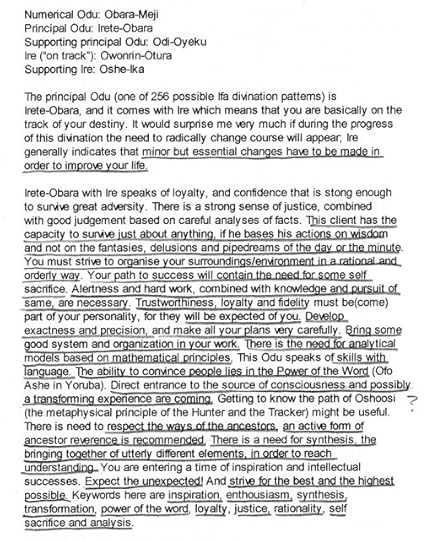
"This client has the capacity to survive just about anything…." Yes, I guess I'm a survivor. "This Odu speaks of skills with the language." Hah! Lord knows I try.


Story of my life.

 Okay.
Okay.

I was just about to move to Nyack, which is on the Hudson. Plenty of forest handy. And, I was about to start a new job with Phobos Entertainment.
Jaap suggested a number of ritual things to do in his "prescription" for me. One involved sacrificing a sheep, but he realized that probably wouldn't be practical.
 So, I didn't sacrifice a sheep. I also didn't cook a soup of tete atetedaye leaves or eat dried mudfish, touch eight fresh eggs to my forehead and smash them in the street. I didn't actually do any of the recommended rituals.
So, I didn't sacrifice a sheep. I also didn't cook a soup of tete atetedaye leaves or eat dried mudfish, touch eight fresh eggs to my forehead and smash them in the street. I didn't actually do any of the recommended rituals.However, the fact was that I was drinking more than I should have around that time. And not eating right. Largely due to lack of money. Too much pizza, rice and beans, hot dogs…cheap stuff. About that, I listened to him.
This passage in the texts he used even he couldn't figure out:
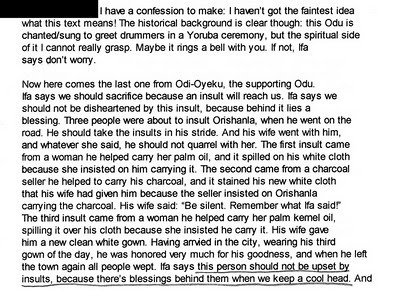 [image error]
This was encouraging:
[image error]
This was encouraging:
 So was this:
So was this:
 This was close to home:
This was close to home:
 And here's the conclusion:
[image error]
[image error]
What's it all mean? I don't know, but I admit I find it fascinating that from halfway around the world this guy had things to say to me that were pertinent. And there were no clinkers.
And here's the conclusion:
[image error]
[image error]
What's it all mean? I don't know, but I admit I find it fascinating that from halfway around the world this guy had things to say to me that were pertinent. And there were no clinkers.
A Premonition
I'll keep this one short. I had my tonsils removed when I was 22 years old. On the way to the hospital (on my Yamaha TX750, by the way) I had the near-irresistible urge to turn around, call it off. No reason at all.
I was prepped for surgery. Lying on a gurney amid a horde of five or six year olds, also on gurnies, also there for tonsillectomies, all staring at me, wondering what the giant was doing there, that feeling came back. If I hadn't been on pre-op tranks that made me woozy, I would have gotten up and left.
In the operating room, the anesthesiologist began administering the sodium pentothal or whatever. He told me to count backwards from 100. I got as far as 99…
…then I felt my heart stop! I stopped breathing!
I had the sensation of falling down a well into blackness. I could hear chaos, shouting, but it seemed father and farther away every second.
Then suddenly I was wide awake. I sat bolt upright. They'd shot me full of epinephrine to counter the anesthetic.
I felt like playing football! Or running a marathon!
The doctor loudly growled at the anesthesiologist, "SHALL WE TAKE IT FROM THE TOP?!"
They did. The tonsils came out. I lived.

A Tarot Reading Scene from a Screenplay I Wrote
The title of the screenplay, written for Plan Z Productions long ago, is The Omega Point. Never produced, though for a while New Line was interested. Then the head of production got canned, and, well, that ended that.
It's actually a science fiction story. A scientist finds a way to make a fundamental change in the universe which effectively makes him godlike. The change he engineers unintentionally causes one man, John Michael, to become chaos-empowered, leading to apparent psychic phenomena happening to and around him, though at first he doesn't understand or believe what's happening.
The cast of characters closely parallels certain Major Arcana of the Waite deck. In this scene, after John has had an inexplicable premonition that enabled him to save his mother's life, his New Age-type secretary reads his Tarot.
INT. AD AGENCY - CONFERENCE ROOM - DAY
John is working. Ruthie enters carrying a pack of cards.RUTHIERuthie has John shuffle. She's using the Waite deck.RUTHIECan I throw your Tarot, Mr. Psychic Hero, sir?JOHNSorry. Not interested. The famous Nannet King herself told me that fortune-tellers are bullshit.RUTHIEI'm not a fortune-teller. With Tarot, you influence the cards and I only tell you what they say. And I can't wait to see what they say about you!JOHNAll right. What the Hell.She lays out a Celtic Cross. As she turns up the cards (which have the names on them) we see them clearly.RUTHIEContemplate whatever you want to know about.RUTHIEJohn gives Ruthie a suspicious look.(Turning up the Hanged Man)The first card represents you. You're firmly attached to your beliefs, but they're being challenged. Love and desire have led you to suffering. You're at the end of your rope...RUTHIEThat's what it means. Really.
(Turning up the Fool)This represents someone trying to help you. The Fool puts himself and his pleasure first, but he can be a brave, if foolhardy ally.JOHNHuh. Vinnie.
RUTHIE(Turning up Death)This means, well, death, or maybe a big change.RUTHIE(Turning up the High Priestess)Ah. She represents your roots, your support, or whatever makes you who you are. She's spiritual power, inner strength and the source of luck.RUTHIE(Turning up the Hermit)This guy's a hidden but important factor. A problem-solver, but someone you wouldn't expect.RUTHIE(Turning up the Magus)This card represents what used to be. The Magus is the energy, the power in everything, everywhere.
RUTHIE(Turning up the Devil)This card represents what's ahead. The Devil means bad times,or a revolutionary new situation.RUTHIE(Turning up the Tower)The Tower stands for a struggle between extreme opposites.
RUTHIE(Turning up the Lovers)This one stands for your dreams or fantasies. Um, moving right along...RUTHIE(Turning up the Empress)She represents an outside influence. She's beauty, sensuality, eroticism, willfulness and material power.RUTHIE(Turning up the Hierophant)The Hierophant, or High Priest. He's an opener of doors, an enabler.RUTHIE(Turning up the Universe)The twelfth card, which represents the key element, is the Universe.RUTHIE(Turning up the Judgment)The thirteenth card, signifies an impending decision or outcome. Amazing. Every single card is one of the Major Arcana. I've never seen that happen before.JOHNSo what's it mean?RUTHIEI think it means that you're going to agonize over making a career change and you're going to meet a really pretty but stuck-up girl.JOHN(Trying to sound sincere)Thanks for the reading, Ruthie.
In the end, John overcomes the enemy and the universe is restored, as it was—with no one but John left aware of what transpired. He is not yet sure who survived the reversal and who didn't.
His secretary again wants to do a reading. Three cards are missing—those that represent the three major antagonists.
INT. JOHN'S OFFICE - DAYRuthie enters with a wrapped deck of cards.RUTHIEJohn, look what I got. A brand new Tarot deck. Let me do you a reading.JOHNDo I have a choice?She opens the pack and sorts through the cards.John flips through the deck. He comes to the Fool.RUTHIEHeyy! The Devil...the High Priest... and the Empress are missing!JOHNHmh. Bliss, Luse and Monica...RUTHIEI got a defective pack!JOHNMaybe not. Maybe that's my reading.JOHNI guess he's still with us.
Vinnie walks in.
VINNIENo autographs.
THE END
NEXT: Byrne's Superman Plot and More
NEXT WEEKEND: My Final, and Most Intense October Tale
Published on October 25, 2011 08:52
October 21, 2011
Stan Meets a Mobster and Other Tales to Astonish
Stan meets Frank Costello
Vince Colletta told me this story. Vince told me a lot of wild stories. At first, I thought he was, as my grandma Elsie might say, "full of potato soup and monkeys." Like the time he told me he was cast for a major role in The Godfather. Long story, but ultimately the role was taken away from him and given to a big-name actor who had big-time clout with the director. Vince said that the casting director quit because of that.
Yeah, right.
1981-ish. Mike Hobson, relatively new publisher at Marvel asked me to go to lunch with him one day. No agenda, just lunch. Mike was making an effort to get to know the creative troops and told me he wouldn't mind if I brought someone along. Vince happened to be in the office, so….
I don't know how it came up, but at lunch, Vince told his I-was-almost-in The Godfather story. It so happened that Mike had been working at the William Morris Agency at the time, was fully aware of the casting dust-up and verified everything Vince said.
Later, Vince showed me a videotape of his screen test, in which he played a mobster being questioned by a Senate subcommittee. He was good.
One way or another, many, many of the seemingly outrageous tales Vince told from time to time were corroborated.
So I tend to believe the stories he told me—this one for instance:
Vince knew guys who knew guys. As far as I know, he wasn't "involved," as they say, with any real-life people resembling characters from The Godfather, but he actually knew, or at least had met a few.
Sometime back in the sixties, Vince and Stan were at P.J. Clarke's, a legendary watering hole at the corner of 55th and Third. Vince noticed Frank Costello and his entourage entering. Costello had been head of the Luciano crime family, and though "retired," was still very influential. He was known as the "Prime Minister of the Underworld," probably the most famous Mafia figure of his era.
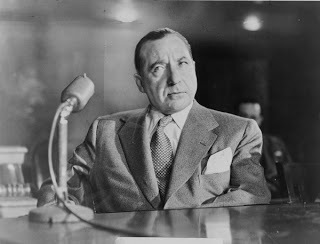 I don't know how Vince knew him—probably from somebody's sister's cousin's wedding or some such. But he knew him, at least well enough to say hello. So he did. He went to Costello's table, exchanged greetings, came back and sat back down with Stan again.
I don't know how Vince knew him—probably from somebody's sister's cousin's wedding or some such. But he knew him, at least well enough to say hello. So he did. He went to Costello's table, exchanged greetings, came back and sat back down with Stan again.Stan asked Vince to introduce him to Costello. Who knows why? Just because he was a larger than life, almost mythic figure, albeit a notorious one? A bad guy? I guess all of us comics types have a fascination with villains as well as heroes.
Vince didn't think that was such a good idea. Stan, said Vince, wouldn't let it go and kept bugging Vince to make the introduction. Finally, he wore Vince down.
So, Vince and Stan went over to Costello's table. Vince introduced Stan. "Mr. Costello, my friend would like to meet you. This is Stan Lee…."
Whereupon Stan stuck his hands up in the air and said, "Pleased to meet you! Don't shoot!"
Rude Dude
While I'm doing first meetings….
Sometime in 1979, I believe, Paul Gulacy called to ask a favor.
Paul lived in Ohio back then, I think. He'd come home from somewhere one day to find a young man sitting on his lawn. A wannabe comic book artist, who absolutely worshipped Paul and his work.
I gather that Paul was polite with the guy. But the guy wouldn't leave. He had come some distance, from I forget where, Wisconsin, maybe, to see Paul, and he wasn't about to go away without accomplishing his mission. The guy begged, insisted, demanded that Paul help him get employment as an artist for Marvel.
Paul told him he couldn't help him. The guy would not take no for an answer. He pretty much camped out on Paul's lawn. Days passed.
So, Paul called me and asked me as a favor to look at the guy's portfolio. He wasn't recommending him, mind you, he just wanted him off the lawn.
Actually, Paul did say that he thought the guy had promise. But mostly he wanted him off the lawn.
I said, sure. For you, Paul, no problem. Paul said the guy's name was Steve Rude.
A few days later, Steve Rude showed up at Marvel. Josie, the receptionist called to tell me he'd arrived. I went to reception and showed him to my office.
His samples, penciled comics pages, looked stylistically like Paul's stuff—but the draftsmanship was very weak. Bad, in fact. Figures out of proportion, misshapen, wonky perspectives…. I launched into what I thought was a gentle, helpful, nice-as-I-could critique. Here's what you need to improve to bring your work up to snuff. That sort of thing.
He argued with me.
He insisted that he was the best artist who had ever crossed our threshold. (!!!)
He declared his work "perfect." He dismissed my criticisms. I obviously didn't know greatness when it was right in front of me. I obviously didn't know anything about art. I obviously didn't know anything.
Throughout he referred to himself in the third person, as "the Dude." This is pretty close: "The Dude is the best. What's wrong with you? Why can't you see that the Dude's work is genius?"
He absolutely insisted, demanded to be given full time work as an artist. He would not take no for an answer. And, he would not leave.
I'm not as polite as Paul. And I'm huge. And in those days, I was in shape.
I didn't touch him, no violence, no contact, but I sort of herded him back toward the reception room and pointed him toward the elevators. I went back to my office.
A few minutes later, I had reason to walk down the hall, headed toward Denny O'Neill's office, I think. And there was the Dude in Al Milgrom's office, showing his portfolio, having the same, bizarro, Dude-rich conversation with Al as he'd had with me.
I chased him out again. Al told me that he'd claimed that I had looked at his "genius" work and sent him down the hall to see him, Al, who would give him a job. Al thought I had gone insane, or that the Dude must be blackmailing me or something.
Josie told me he'd hung around the reception room and when she'd buzzed the door open to let someone else in, he'd zipped in right behind them before the door closed.
I told Josie if it happened again to call me right away.
A few minutes later, on my way to the production department, as I passed Jim Salicrup's office (I think) there he was again! Same drill. Dude!
ARRRGH!
He'd hung around the back door, by the mailroom—no receptionist there—and when someone opened it to go in or out, he'd slipped in again.
I threw him out again and threatened to call the police.
Three times in the space of half an hour I threw Steve Rude out of the Marvel offices.
Geez, Louise. Rude, indeed.
Over the next two or three years he changed his style, got better and turned out okay, I hear.
I haven't had any dealings with him since the Day of the Rude Dude at Marvel, other than saying hello at conventions and such. From people at Dark Horse, who have had dealings with him, I've heard that he's still, shall we say, not humble. Not the easiest-to-deal-with Dude. Genius, though. He got that down.
Anyway….
I wonder how he tells that story?
Going Bananas with Dino DeLaurentiis
Final "meeting" story for now.
Sometime during the spring of 1980, Dino DeLaurentiis optioned the rights to the Ghost Rider.
Because the Dazzler movie treatment I'd written had gotten good reaction, I was asked to write, or pick someone to write a treatment for the potential Ghost Rider film. And DeLaurentiis was going to pay for the treatment!
If it had to be done for free and in a hurry, I would have taken the bullet. But there was money! And it wasn't a killer deadline! So, I asked the best comics writer I knew, possibly the best writer, period, Archie Goodwin, to give it a go.
Archie wanted to do it, and he certainly had use for the dough, but as I've said before, he was a very slow writer. He was reluctant to commit. He said it might be okay if we did it together.
Okay. Cool.
My plan was to let Archie do as much of it as he wanted to or could and pitch in when and where he needed a hand. Deal.
First, we had to meet with Dino DeLaurentiis to get the marching orders. One afternoon, we trudged from 575 Madison over to the Gulf & Western building where Dino had an office.
Dino's stupefyingly beautiful secretary, dressed for a Paris Fashion Week catwalk (didn't they used to be called runways?) escorted us into his basketball court-sized office.
The office décor was interesting. It was basically a shrine to King Kong. Framed posters and giant-sized stills from the film. Bronze statues of Kong. Paintings of Kong. Artifacts and souvenirs from the film on display. Even items from the original 1933 movie. Welcome to the King Kong Museum.
Dino had a thick accent. I'm not good at replicating accents, but bear with me for just this one attempt. His very first words to us were: "Didda you seeya my Kong?"
Well, both of us had, and mumbled some praise. I was still thinking about the secretary….
Then we got down to business. Dino explained what he wanted from us. As he was talking, I noticed Archie looking around at all the Kong stuff and I sensed that some switch had been tripped inside his brain.
Archie had a fairly dignified look about him. He was 14 years older than me. He was respected and admired by everyone. Oh, but if they only knew…!
Arch could clown with the best of them. He was, for instance, the master of the pratfall. He could appear to fall face down, hard, causing great consternation among onlookers, then bounce up, face un-smashed, laughing.
The very first day he was Editor in Chief, production manager Big John Verpoorten came to his office, loomed menacingly in the doorway and growled, "Everything is late! What are you going to do about it?!" Archie said nothing, went liquid, and melted out of his chair down to the floor under his desk, leaving Big John staring at an empty chair. "Now what am I supposed to do?!" John fumed, and stomped away. Archie came back up and started working again as if nothing had happened.
Once as we were crossing the street, a pickup truck with a gun rack was sitting at the light. Archie leaped up onto the fender shouting, "Look at me, I'm a deer!"
Get the drift?
So Dino says he wants us to really think it through, explore every possibility.
"Okay," says Arch. "We'll monkey around with it."
Dino says think big….
"You want us to go ape?" asks Archie.
Don't worry about budget….
"We'll go bananas!"
It got worse. Every simian reference conceivable.
About the deadline….
"When do you want the whole Magilla?"
All of this went waaay over Dino's head. English not his first language.I, however, couldn't keep a straight face. I was giggling like a schoolgirl.
Dino kept looking at me as if I were crazy, weird or on drugs.
"This," said Arch, deadpan, "is going to be more fun than…"
No, no, no! Don't say it!
"…a barrel of monkeys!"
BWA-HA-HAA!
As we marched back to Marvel, Goodwin looked smug. I was just glad I didn't wet my pants laughing.
So we wrote the thing. The basic idea was Archie's and he wrote most of the first half. Then he went on a trip with the family he'd had planned, so I wrote the last half. The ending is mine. We hadn't worked that out before he left, but when he eventually read it, he seemed happy with it. A "this is okay" from Archie was as good as gushing praise from anyone else.
Nothing came of the project.
Here's a letter I got from Dino's organization:
[image error]
The treatment is available for download in the sidebar.
Miscellaneous Finds
Here's a fake press release, a response to Mike Hobson's joking requests for a new title:
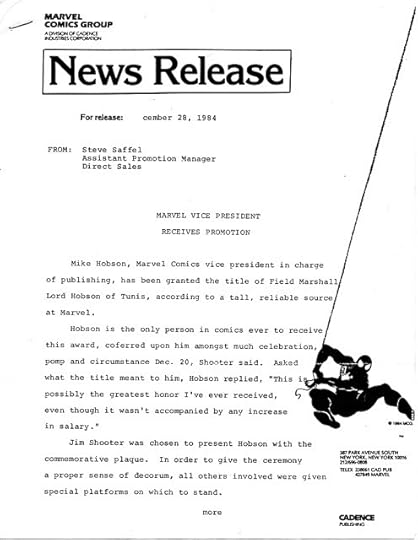
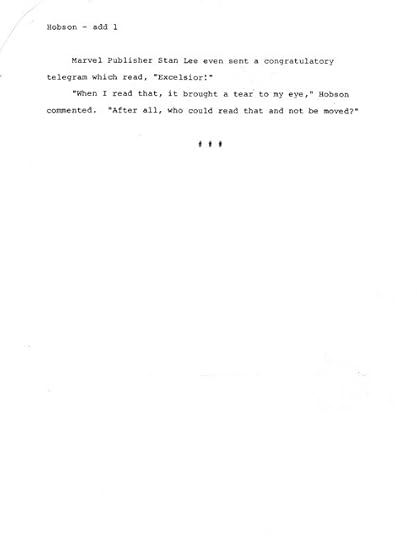 Here are my old Marvel business card and my Valiant Entertainment business card:
[image error]
Here's an issue of Daredevil that JayJay turned up with partial writing credit to Harlan Ellison. I said he never wrote for Marvel on my watch, but apparently he did. I'll try to find out the story behind this, because, honestly, I forget.
Here are my old Marvel business card and my Valiant Entertainment business card:
[image error]
Here's an issue of Daredevil that JayJay turned up with partial writing credit to Harlan Ellison. I said he never wrote for Marvel on my watch, but apparently he did. I'll try to find out the story behind this, because, honestly, I forget.
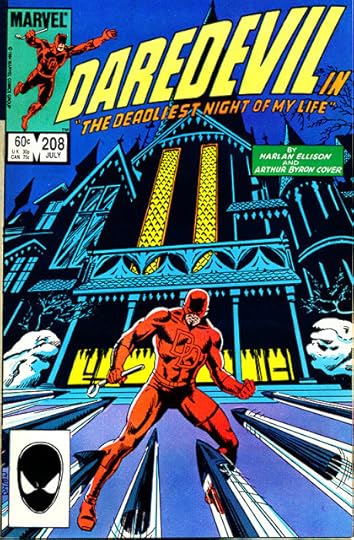 (Here's a link to the story behind Harlan's Daredevil stories. Thanks JediJones! ~ JayJay)
(Here's a link to the story behind Harlan's Daredevil stories. Thanks JediJones! ~ JayJay)And looky-looky what I found. I'll tell you more about it later. (as discussed in Superman - First Marvel Issue ~JayJay)

Use of Proceeds
To date, donations given to support this blog have totaled $989.00. Of that, a small amount has been put aside for basic blogging expenses that JayJay can explain and I can't. The rest of the money has gone to buy food pellets for her and/or whatever Blog Elves require to survive. Because JayJay spends a lot of time and puts in a lot of effort to get this thing online and I haven't been able to pay her since May.
At the point that any revenues we may get from ads is sufficient to cover expenses and keep the Blog Elf well-fed and sleek, I will stop asking for donations, and in fact, refuse them.
Published on October 21, 2011 16:10
October 20, 2011
ULTIMATE COMICS – All-New Spider-Man #2
An Apology
A number of people commented that my assessment of Brian Michael Bendis's writing effort on All-New Spider-Man #1 was too harsh and too personal. I said that he phoned it in, relieving Marvel of "easy money." I also referred to the Marvel editorial people involved as "bozos" who are "clueless."
I'm sorry. I don't know Bendis, and as Tom Brevoort pointed out, I wasn't there. I don't know how hard he tried and I don't know if he was snickering when he cashed the checks.
I also shouldn't have said the editorial people were bozos. Clueless, yes, I'll stick with that. I'll stick with my unfavorable assessments made elsewhere of the creative management at both Marvel and DC (Didio/Lee, Fine/Buckley, et al), and my negative opinions of the tippy-top brass at both companies who inexplicably allow the madness below.
But my remarks about Bendis? No excuse. It was over the top. But I offer this explanation.
I wanted to like that book. I really wanted to like that book. Bendis is Marvel's top gun. I expected to like that book. But the writing really let me down. There wasn't much of it, some of it was weak and there was not so much as a nod to the fact that the work was done for a serialized presentation.
And it was a Marvel book.
They—I almost typed "we"—should be better.
Somewhere in my dark little heart of hearts, I still have some Marvel in me. I remember the days I was Editor in Chief when DC out-promoted us, out-advertised us, had better production values, had movies while we had none, had more household name characters and we still outsold them three to one. Why? Because, in the words of our circulation V.P. Ed Shukin, we "beat 'em between the covers." We were better. We won with good stories, well told. Generally better than theirs, anyway.
On some level, irrationally, perhaps, I still expect Marvel to show superior creative acumen. It shocks and appalls me when the number one writer at Marvel on Spider-Man(!), given good art falls short.
So I was more emotional than is proper. Again, sorry. I'll try not to let it happen again.
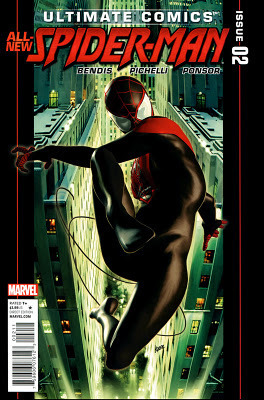
All-New Spider-Man #2
The Cover:
Another swinging through the city pin-up. Better than the last one, but if Marvel is dead-set on sticking to the Bill Jemas all-pin-ups-all-the-time philosophy, how about a different one? How about sticking to a wall? We haven't seen that standard riff yet.
The Interior:
Art:
It's still good.
JayJay the Blog Elf chastised me for not nit-picking the art more last issue. A specific thing she brought up was that Miles Morales appears to be very much a little kid when we first see him but morphs into a lanky, teen-looking guy later, in the scene with Uncle Aaron. She's right. And there are more quibbles available to be quibbled, but, glorioski, if I got art up to this standard for my stories, I'd be very happy.
The Story:
Better, I'm happy to say.
But….
They start us out with an introductory caption that says the following:
"Months ago, before the original Spider-Man died, grade-schooler Miles Morales was about to start a new chapter in his life in a new school—when he is suddenly bitten by a stolen, genetically altered spider that gave him incredible, arachnid-like powers."
New reader me learns that the original Spider-Man is dead in an intro on the inside front cover. That wasn't mentioned last issue, except in references made in the lettercolumn, which I don't think you can count on everyone reading.
Your average civilian these days has at least heard of Spider-Man. I think Spider-Man being dead is a newsy note significant enough to be included in the story.
Wait a minute. Is he dead? This mixed verb-tense paragraph leaves me wondering. "Months ago, before the original Spider-Man died….(Miles) is suddenly bitten…."
So…the original Spider-Man isn't dead yet? I guess? This story is actually months ago…compared to some story in which Spider-Man dies, which I haven't read and am unaware of? Oh, I don't know.
I wonder if it's relevant.
Little intros and mission statements, as in DC's New 52 Preview, and such really ought to be written more carefully.
Anyway….
It begins with a boy running down the street. If you read last issue, you know it's Miles, the "grade-schooler" referred to in the introduction. If not, it, well…some kid is running.
He makes an impossible leap over an obstacle. When people react to that, he turns invisible and slips away. He's upset, apparently worried about the very things we've just witnessed.
Later, visible again, he is menaced by a big, mean teen. Miles grabs the guy's arm and delivers some kind of electric shock or "zap." I say electric shock because of the little lightning bolt "emanata" (a Mort Walker term) around Miles' hand. Again, he gets away.
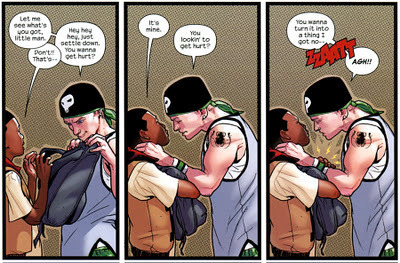 I have these questions:How does Miles know he can make the impossible leap? Afterwards, he looks surprised. What prompted him to try it? How does Miles know he can electro-shock people? I suppose we can assume that instinct prompted the turning invisible thing when everyone was staring at him and the electric shock delivered when he was threatened. I guess.And:If I didn't happen to read last issue, who is this kid?If I did happen to read last issue, when is this taking place?At the end of four pages, New Reader me is left with the impression that this kid is a mutant, which is what the mean teens and others call him, that he can make seven-foot high, 20-foot long (estimated) leaps, turn invisible, give electro-shocks…and all of that is apparently a new to him and troubling.
I have these questions:How does Miles know he can make the impossible leap? Afterwards, he looks surprised. What prompted him to try it? How does Miles know he can electro-shock people? I suppose we can assume that instinct prompted the turning invisible thing when everyone was staring at him and the electric shock delivered when he was threatened. I guess.And:If I didn't happen to read last issue, who is this kid?If I did happen to read last issue, when is this taking place?At the end of four pages, New Reader me is left with the impression that this kid is a mutant, which is what the mean teens and others call him, that he can make seven-foot high, 20-foot long (estimated) leaps, turn invisible, give electro-shocks…and all of that is apparently a new to him and troubling. There is no splash page. No title, except for "Part Two," seen on the inside front cover. I miss those things. Maybe that's just me being old-fashioned.
Page five, first panel, what to my wondering eyes should appear but LEGOS!
Hoo-hah! This story was written for me! Love those Lego blocks! [image error] Miles takes his friend Ganke into his confidence. In the course of doing so, Miles demonstrates his new abilities. We also learn his name, Miles, and get the skinny on what happened last issue. We find out that what we're seeing immediately follows the events of last issue.
Smoothly, elegantly, naturally done by Bendis. There's the guy I've read before.
Miles father shows up. He's peeved.
In the ensuing conversation between Miles and dad, skillfully written, well drawn—make that brilliantly drawn—we learn a lot about dad and Uncle Aaron, who we saw last issue, well-established here in absentia. As a result of a confession of sorts by dad, father and son bond a bit.
Just as Miles is about to spill the beans to dad about what has happened to him, two shall we say unusual figures zoom by. One appears to be aflame. Miles mentions the "Human Torch." New Reader me guesses the fiery-looking guy was him. Comics-savvy me knows the other one is Iceman, or some current iteration of same. I cannot guess what a not-in-the-know civilian would make of him. Would they even know that's ice under him?
Anyway, dad expresses disdain for such "mutants," which effectively heads off Miles' telling him he's a mutant.
The Torch and Iceman's arrival is an incredibly convenient coincidence.
That night, friend Ganke texts Miles his considered opinion of what Miles really has become—not a mutant, but like whatever Spider-Man is.
I (both of me) learn that Spider-Man, the old one, disclosed to a reporter that he'd gotten his super powers as a result of being bitten by a spider. Like Miles.
He points out that some spiders have "chameleon like powers" and a "venom strike" like Miles.
That's nonsense, of course. The art shows Miles becoming transparent and invisible. Not chameleon-like, or chameleon-ish spider-like at all.
And, if you're going to tell me that, no, he's just blending in with his background so well that he seems invisible—from any angle, and 360º all at once, no matter how complex the background or how far away myriad background elements are, I say show me such a spider.
"Venom strike?" What? That electric shock thing that makes a pirate ship built of Legos explode? You're kidding me, Bendis. What does that have in common with a spider's venom?
Whatever.
Ganke's final text says "R U Spider-Man?!!
Miles ponders,
Out of nowhere there's a panel of the Spider-Man New Reader me recognizes. Comics-savvy me realizes that it represents Miles thinking about old Spider-Man. New Reader me doesn't get it. A lot of new readers probably don't get it. It's a totally confusing, jarring element. They assume that old Spider-Man is there. Yeah, they do. Trust me. Or don't, but yeah, they do.
I know it's hard for you comics-savvy people out there to accept this, but things like that image of old Spider-Man, suddenly just there with no explanation other than Miles' "pondering" expressions in panels thereabouts, throws many inexperienced readers off. Such things can ruin a story for the uninitiated. It gives them an expectation that Spider-Man is there, that something is going to happen with Spider-Man, and when it doesn't, they sometimes toss the book away and never pick up another one because, to them, it's a bunch of non-sequitur crap.
But we savvy types get it.
Miles is inspired to try crawling up the wall, Spider-Man-like, and succeeds.
"Oh, no," he says.
Here endeth the fascicle.
Here's the good news.
More figurative, story-element Lego blocks have been provided, and some of the ones scattered about last issue are starting to fit together with these new ones. Bendis may yet build us a cute little Lego choo-choo, or maybe a pirate ship. My faith in him has been borne out to some extent.
One could pick up this issue, having missed the first, read it and understand it. Even new readers, except for that shot of old Spider-Man.
It's interesting and engaging. I'm beginning to like the kid, Miles. Those who said he was introduced in those three pages last issue in which he wins the lottery to get into what must, per the intro caption on cover two, be a middle school, are wrong. Sorry, Tom Brevoort. That was no introduction. But in this issue, we do get to know him some. Nice kid.
It's another decompressed issue. Two issues and eight bucks into this, not much has happened—but in this issue, the not much was engagingly presented. There are still lonely Lego blocks, like the Norman Osborn block and the Doctor Markus block that haven't snapped in anywhere yet.
And the old Spider-Man block.
And what happened to Spider #42?!
I'm not thrilled with this issue. But like I said, it's better.
Enough of this for a while….
NEXT: Stan Meets a Mobster and Other Tales to Astonish
THIS WEEKEND: Uncanny Divinations and Premonitions
Published on October 20, 2011 11:51
October 18, 2011
ULTIMATE COMICS – All-New Spider-Man #1
First This
Video of the NYCC panel I participated in, "Screen Future: Gaming, Comics and TV Around the World and Five Years from Now" may be found here . The panel was moderated by Intel Corporation Futurist Brian David Johnson and included savvy SyFy Channel exec Craig Engler and renowned SF author/visionary Cory Doctorow.
All-New Spider-Man #1
The Cover:
The "standard" cover features Spider-Man swinging through the city, a standard riff. Spider-Man's pose isn't distinctive. Make the web into a rope and it could be Robin just as easily. It is also nonsensical, in the sense that the figure doesn't really seem to be swinging on the web-line. It's as if he was floating past and reached out to grab it.
[image error]
Pretty much every shot of the Spider-Man Steve Ditko co-created and drew had him in a pose that was distinctively Spider-Man and nobody else. Ditko also pretty much always made it appear that the web-line was actually supporting him as he swooped along in a series of graceful arcs. Ditko understood the dynamics of a body swinging on a line and the laws of pendular motion.
(ASIDE: I never liked John Romita's approach to Spider-Man. I love John. He's a Hall-of-Famer. All-time great. Grandmaster. And a great human being. But his theories of how to draw Spider-Man appalled me. I hated the fact that he simplified the costume. I'd hear him explaining to some young artist that one of the lines on the mask represented the bottom of Spider-Man's nose and one his mouth. What?! Worse, he'd tell people not to worry about the physics of web-swinging. Just have the web-line go off panel, he'd tell them. It's just a trumped-up device to justify "flying," said he, think of it as pulling Spider-Man along.
ARRRGH!
As Editor in Chief, I could have insisted that re-Ditko-izing Spider-Man was policy, and that John should represent it. But, I inherited John and his long-established philosophies when I became boss. They were grandfathered in, sort of. Seemed like it would be a difficult conversation: "John, I know you've drawn Spider-Man for a long time, and to a great extent your version has become the accepted benchmark, but you're doing it all wrong." I just don't think that conversation would have gone very well.
Stan agreed with my take on the character and proper presentation of Spider-Man for the most part, but, if I understood Stan at all, he had the same reservations as I did about criticizing or correcting John. He actually did try to gently nudge John toward a more Ditko-y approach in some respects—so did I—but when you have an Exalted Elder, a Superstar like John who does so many things brilliantly, sometimes it makes sense to benignly neglect a thing or two.
So when John drew the web-line going off panel and apparently pulling Spider-Man along into the air, I gritted my teeth, imagined that the web-line was attached to a passing helicopter and comforted myself with a handful of jellybeans.
P.S. Aside from the occasional artist passing by who asked John's opinion, or the "Romita's Raiders" art assistants supervised by John, who did the minor art correx, John wasn't involved in directing the artists who actually drew the comic books, so to some degree his philosophies were academic. The various editors and I generally favored and preached a somewhat more Ditko-esque approach.)
The costume the character is wearing on the cover in question is different from Ditko's or even Romita's simplification of Ditko's, but I suppose even a new reader or civilian would figure it was Spider-Man. Like Batman or Superman, Spider-Man has achieved a very high-level Q-Score. Some people might take the character to be a spin-off Spider-Boy, but most won't be too puzzled.
I like the Ditko costume better. That's just me. It's not a legit criticism for the purposes here, where I'm trying to stick to the basic principles of comics creation and publishing rather than personal tastes.
While I'm at it, though, I do not like the McFarlane webs. Whether they come from mechanical web-shooters or from spinnerets inexplicably located in his forearms (yuck) the sheer mass of that thick, tangly rope of stuff is absurd. And that is a legit point. It's a logical clinker that will give some people pause. Maybe only a few of us, but…it doesn't have to be that way.
The logo is reasonably readable. Red pops against light or dark backgrounds, for the most part. If stuck with this cover art, I would have made the red pure, not muddied/grayed down. I might have tried a white drop shadow instead of black, to see how it would look. Might be worse, might be better. Hard to guess without seeing it mocked up.
The drawing is okay. The arbitrary white and sometimes blue outline around the figure is…arbitrary—an abstraction inconsistent with the illustrative background. It's there to make the character pop, but it's unnecessary. The character is strongly backlit. Slightly bolder edge-lighting would have accomplished the same thing.
So, it's a flawed, okay-ish pin-up.
For part of the time I worked (secretly, at their insistence) for the unlearned children who ran Valiant Entertainment, Inc., Bill Jemas, former Marvel publishing V.P., served as a consultant to VEI. I would often try to gently explain various publishing or comics 101 things to the children. Bill would flat out tell them they were idiots. He soon figured out that I knew what I was doing. More than once, he told the children "Just do what he says."
They almost never did.
The one place Bill and I parted company biz philosophy-wise, however, was on the subject of covers. Bill thought they should all be pin-ups. Character glamour shots. Period. Generate iconic branding images and use them everywhere. Period. Who gives a damn what's in the book?
Well, I do like the occasional pin-up, especially on a first issue. But there's no reason a cover illustration can't be a powerful, iconic image and relate to the content. Offer a "hook."
I designed a slew of covers related to the stories I was working on to demonstrate the children and Bill what I meant. I'd show you some of those scribble sketches, but the children have already sued me once for absurd things like alleged violations of a contract that was never presented to me, much less signed, leaking their "trade secrets," and leaving them to take a better job, which they claimed somehow foiled their plans to acquire a license that had already been acquired years earlier by Dark Horse.
Anyone can sue anyone for anything in these United States. Doesn't matter how inane or insane the lawsuit is, it still costs money to fend it off. What a country.
That spurious suit, as it turned out, seemed to amount to a clumsy attempt to manipulate Mike Richardson into some deal they wished he would make with them. Mike is not easily manipulated. The ploy failed and the suit was eventually withdrawn.
So, no examples. But they'll still probably sue me for calling them children.
Back to the cover. Jemas's philosophy apparently still holds sway at Marvel. Pin-up. Generic. Okay, but if so, for a first issue, it ought to be better, stronger. Or offer a hook.
The first variant is a bad drawing. The anatomy looks wonky. What is going on with Spider-Man's left leg? How the Hell can that foot be connected to the stump of a thigh we see? This is a badly broken body. [image error] John Romita would in his charming and gentle way clue the artist in about how to approach such a shot. How to un-bunch the figure just enough so that at a glance, the limbs looked like they belonged where they were and there were no anatomical impossibilities or visual conundrums.
John used to laugh when he'd see some artist's drawing of a character—usually, it was Superman, occasionally Thor—flying right toward the camera so that what you saw was head, shoulders, chest, arms…and half of each foot apparently sticking out of his chest. Legs completely hidden by his body. It looks so weird and wrong. So simple to change the view ever so slightly so that a hint of body below the chest, and a hint of legs—just a sliver—can be seen, avoiding pec-ped syndrome.
The second variant features Spider-Man unmasked. He's leaping, I guess, though the pose is close to a sticking-to-the-wall pose. It takes me a tenth of a second to realize that, nah, that wall behind him is some distance away. He must be in the air. [image error] If Ditko in his prime had drawn this—or Kirby, or anyone with solid fundamentals—there would be not a fraction of a second of doubt. If John Romita, either of them, had seen it, they probably would have mentioned to the artist in their family-trait gentlemanly manner that it could be a smidge better if clearer in that regard, and told them how to make it so. And the artist would have thanked them sincerely and rushed away to touch up the cover, eager to benefit from their wisdom.
If I had told them the same thing, as politely as a monster can manage, they might have grudgingly improved the pin-up, but probably would have condemned me in the fan press as a megalomaniac. "You know how he is." : )
I guess the hook they were going for here is that the person in the suit is not who we might expect. That's a little thin, but whatever.
No issues with the logo in either of the variants.
Standard cover by Kaare Andrews, variants by Sara Pichelli and Justin Ponsor.
The Interior:
Art:
It's pretty good. The storytelling is pretty clear. The draftsmanship is pretty good. The coloring is pretty good. It reads well. It's visually interesting. The acting and expressions are good.
Generally a good job by Sara Pichelli, artist, and Justin Ponsor, colorist.
The Story:
Pretty bad.
The first six pages introduce Doctor Markus, Norman Osborn and Spider #42. Markus is apparently a capable, sought-after scientist of great accomplishment with "four doctorates" who doesn't know what the word "spinstress" means. [image error] Osborn, we can assume he's the principal of "Osborn Industries." He hired Markus.
We also see Spider #42, presumably a research specimen.
Osborn wants Markus to "be Athena," who transformed a person into a spider.
Osborn reveals that he, Osborn, "created Spider-Man." One of his genetically altered spiders (like #42, one assumes) bit a young man who gained spider-like powers as a result.
Otto Octavius is mentioned as an authority on such transformations. Osborn makes it clear that he has issues with O.O. Oh-oh….
Osborn also threatens Markus's life if he should leak any information. Trade secrets? At least the VEI villains only sue you….
Osborn is played pretty broadly, almost Snidely Whiplash villainous.
Markus is apparently sufficiently unnerved that he lets Spider #42 escape. #42 is on the loose. The sequence ends with the front page of a newspaper, sort of—it's very fake and unconvincing—that serves as a mechanism for exposition. From this we learn, courtesy of S.H.I.E.L.D, a "world peacekeeping task force," that Norman Osborn experimented on himself using a "super-soldier formula" that "altered" him into the "Green Goblin." He attacked a high school, an event coincidental with the debut of the "mystery man called Spider-Man."
The sequence ends with the front page of a newspaper, sort of—it's very fake and unconvincing—that serves as a mechanism for exposition. From this we learn, courtesy of S.H.I.E.L.D, a "world peacekeeping task force," that Norman Osborn experimented on himself using a "super-soldier formula" that "altered" him into the "Green Goblin." He attacked a high school, an event coincidental with the debut of the "mystery man called Spider-Man."
Pause here.
In comics-savvy-me mode, I know who Norman Osborn, Otto Octavius, and the Green Goblin are. I know pretty well who Spider-Man is, though the Spider-Man on all three covers and the one showing his face especially isn't the one I'm familiar with. I know, sort of, what S.H.I.E.L.D is.
In New Reader/civilian mode, aside from a rudimentary knowledge of who Spider-Man is, and possibly who the Green Goblin is, I know only what is presented here, in this issue. None of the above was presented in such a chaotic fashion that I can't cope and press on hoping for answers to the myriad questions that are accumulating, but we're on page seven, now. Come on!
No luck.
Unaware of what effects the incidents sketched out the newspaper story we saw have anything to do with this story (the one in this issue) we move along and see a masked, costumed cat burglar breaking into Osborn Industries' laboratory. It wasn't until I saw the matching shot of the lab, seen before, that I understood the location. Aha! Then I grokked that the big "OI" seen in panel one must stand for Osborn Industries. It looks a little overgrown.
I'm going to take a great leap here and figure that the newspaper article is meant to imply that Norman Osborn/the Green Goblin has been dealt with somehow, and his business is languishing. Poor Dr. Markus. Unemployed.
The burglar steals some things, including a red box, given some special play, so it must be important. Something inside emits light…. The burglar is pleased. [image error] Spider #42 finds its way into the burglar's swag bag.
The burglar apparently gets away.
Now we meet Miles Morales and parents. Three pages are spent getting him selected by lottery to attend a special school, the "Brooklyn Visions Academy," apparently a high school of the same ilk as New York's High School of Art and Design, the High School of Performing Arts or the Bronx High School of Science.
(ASIDE: A standard cheer offered up by "Science High" students in support of their football team goes: "Harrass them, harangue, them, make them relinquish the ball!" Eggheads. What'cha gonna do?)
Miles is selected because #42 is picked. A spooky coincidence. Get it? Miles seems vaguely unsettled by this whole business. He goes to visit Uncle Aaron, clearly a sympathetic friend.
Miles seems vaguely unsettled by this whole business. He goes to visit Uncle Aaron, clearly a sympathetic friend.
We see the swag bag established before and the mysterious red box. Uncle Aaron is the burglar!
Spider #42 finds its way out of the swag bag, onto Miles' hand and bites him. Miles passes out. What becomes of Spider #42 isn't told.
Miles passes out. What becomes of Spider #42 isn't told.
Uncle Aaron calls Miles' father who rushes to see about his son. As would I.
Miles seems okay. His dad is very suspicious of his brother, Aaron, and accusatory. He clearly knows Aaron is a ne'er-do-well.
Miles slips away as they're arguing.
Dad goes looking for Miles and walks right past him because Miles is becoming invisible. I pause to gather myself….
I pause to gather myself….
Good grief.
So what do we have here?
A bushel of coincidences that would make Thomas Hardy blush.
A series of unlikely events, many related to the movements of spider 42.
A pile of people and things introduced or mentioned that are irrelevant to the issue in hand.
More items devoid of meaning and questions unanswered in the episode in question than one would ever encounter in any professionally written TV show. Even the worst.
A bunch of Lego blocks—not a very big bunch—spilled out onto a table that, with the addition of many, many more blocks might someday become a cute little choo-choo or something. Not enough blocks here even for the cow catcher, though. It's going to take a lot more blocks. This thing is the decompression gold medal winner. Three pages to get the kid accepted at a high school by random drawing? Which has precious little bearing on whatever the Hell is going on? Three? Of 21? Really?
Brian Michael Bendis is the writer, so savvy-me knows that there will be more Lego blocks, and that a choo-choo is in the offing. Eventually.
New Reader me couldn't care less. I quit reading somewhere on page ten.
The dialogue is reasonably natural when Snidely Whiplash isn't talking.
But all in all, this is pathetic. It's the writer's fault. The artists are capable enough.
So is the writer, judging from other things I've seen. He's not stupid, untalented or unskilled. He obviously phoned this one in (and many others, I suspect). Easy money. Why not, if the Marvel editorial bozos are clueless enough to pay for six pages worth of story fragments crammed into 21 pages, with reckless disregard for, to paraphrase Twain, slovenliness of form?
Feh.
And people wonder why comics don't sell.
NEXT: I Force Myself to Endure #2. Feh.
Video of the NYCC panel I participated in, "Screen Future: Gaming, Comics and TV Around the World and Five Years from Now" may be found here . The panel was moderated by Intel Corporation Futurist Brian David Johnson and included savvy SyFy Channel exec Craig Engler and renowned SF author/visionary Cory Doctorow.
All-New Spider-Man #1
The Cover:
The "standard" cover features Spider-Man swinging through the city, a standard riff. Spider-Man's pose isn't distinctive. Make the web into a rope and it could be Robin just as easily. It is also nonsensical, in the sense that the figure doesn't really seem to be swinging on the web-line. It's as if he was floating past and reached out to grab it.
[image error]
Pretty much every shot of the Spider-Man Steve Ditko co-created and drew had him in a pose that was distinctively Spider-Man and nobody else. Ditko also pretty much always made it appear that the web-line was actually supporting him as he swooped along in a series of graceful arcs. Ditko understood the dynamics of a body swinging on a line and the laws of pendular motion.
(ASIDE: I never liked John Romita's approach to Spider-Man. I love John. He's a Hall-of-Famer. All-time great. Grandmaster. And a great human being. But his theories of how to draw Spider-Man appalled me. I hated the fact that he simplified the costume. I'd hear him explaining to some young artist that one of the lines on the mask represented the bottom of Spider-Man's nose and one his mouth. What?! Worse, he'd tell people not to worry about the physics of web-swinging. Just have the web-line go off panel, he'd tell them. It's just a trumped-up device to justify "flying," said he, think of it as pulling Spider-Man along.
ARRRGH!
As Editor in Chief, I could have insisted that re-Ditko-izing Spider-Man was policy, and that John should represent it. But, I inherited John and his long-established philosophies when I became boss. They were grandfathered in, sort of. Seemed like it would be a difficult conversation: "John, I know you've drawn Spider-Man for a long time, and to a great extent your version has become the accepted benchmark, but you're doing it all wrong." I just don't think that conversation would have gone very well.
Stan agreed with my take on the character and proper presentation of Spider-Man for the most part, but, if I understood Stan at all, he had the same reservations as I did about criticizing or correcting John. He actually did try to gently nudge John toward a more Ditko-y approach in some respects—so did I—but when you have an Exalted Elder, a Superstar like John who does so many things brilliantly, sometimes it makes sense to benignly neglect a thing or two.
So when John drew the web-line going off panel and apparently pulling Spider-Man along into the air, I gritted my teeth, imagined that the web-line was attached to a passing helicopter and comforted myself with a handful of jellybeans.
P.S. Aside from the occasional artist passing by who asked John's opinion, or the "Romita's Raiders" art assistants supervised by John, who did the minor art correx, John wasn't involved in directing the artists who actually drew the comic books, so to some degree his philosophies were academic. The various editors and I generally favored and preached a somewhat more Ditko-esque approach.)
The costume the character is wearing on the cover in question is different from Ditko's or even Romita's simplification of Ditko's, but I suppose even a new reader or civilian would figure it was Spider-Man. Like Batman or Superman, Spider-Man has achieved a very high-level Q-Score. Some people might take the character to be a spin-off Spider-Boy, but most won't be too puzzled.
I like the Ditko costume better. That's just me. It's not a legit criticism for the purposes here, where I'm trying to stick to the basic principles of comics creation and publishing rather than personal tastes.
While I'm at it, though, I do not like the McFarlane webs. Whether they come from mechanical web-shooters or from spinnerets inexplicably located in his forearms (yuck) the sheer mass of that thick, tangly rope of stuff is absurd. And that is a legit point. It's a logical clinker that will give some people pause. Maybe only a few of us, but…it doesn't have to be that way.
The logo is reasonably readable. Red pops against light or dark backgrounds, for the most part. If stuck with this cover art, I would have made the red pure, not muddied/grayed down. I might have tried a white drop shadow instead of black, to see how it would look. Might be worse, might be better. Hard to guess without seeing it mocked up.
The drawing is okay. The arbitrary white and sometimes blue outline around the figure is…arbitrary—an abstraction inconsistent with the illustrative background. It's there to make the character pop, but it's unnecessary. The character is strongly backlit. Slightly bolder edge-lighting would have accomplished the same thing.
So, it's a flawed, okay-ish pin-up.
For part of the time I worked (secretly, at their insistence) for the unlearned children who ran Valiant Entertainment, Inc., Bill Jemas, former Marvel publishing V.P., served as a consultant to VEI. I would often try to gently explain various publishing or comics 101 things to the children. Bill would flat out tell them they were idiots. He soon figured out that I knew what I was doing. More than once, he told the children "Just do what he says."
They almost never did.
The one place Bill and I parted company biz philosophy-wise, however, was on the subject of covers. Bill thought they should all be pin-ups. Character glamour shots. Period. Generate iconic branding images and use them everywhere. Period. Who gives a damn what's in the book?
Well, I do like the occasional pin-up, especially on a first issue. But there's no reason a cover illustration can't be a powerful, iconic image and relate to the content. Offer a "hook."
I designed a slew of covers related to the stories I was working on to demonstrate the children and Bill what I meant. I'd show you some of those scribble sketches, but the children have already sued me once for absurd things like alleged violations of a contract that was never presented to me, much less signed, leaking their "trade secrets," and leaving them to take a better job, which they claimed somehow foiled their plans to acquire a license that had already been acquired years earlier by Dark Horse.
Anyone can sue anyone for anything in these United States. Doesn't matter how inane or insane the lawsuit is, it still costs money to fend it off. What a country.
That spurious suit, as it turned out, seemed to amount to a clumsy attempt to manipulate Mike Richardson into some deal they wished he would make with them. Mike is not easily manipulated. The ploy failed and the suit was eventually withdrawn.
So, no examples. But they'll still probably sue me for calling them children.
Back to the cover. Jemas's philosophy apparently still holds sway at Marvel. Pin-up. Generic. Okay, but if so, for a first issue, it ought to be better, stronger. Or offer a hook.
The first variant is a bad drawing. The anatomy looks wonky. What is going on with Spider-Man's left leg? How the Hell can that foot be connected to the stump of a thigh we see? This is a badly broken body. [image error] John Romita would in his charming and gentle way clue the artist in about how to approach such a shot. How to un-bunch the figure just enough so that at a glance, the limbs looked like they belonged where they were and there were no anatomical impossibilities or visual conundrums.
John used to laugh when he'd see some artist's drawing of a character—usually, it was Superman, occasionally Thor—flying right toward the camera so that what you saw was head, shoulders, chest, arms…and half of each foot apparently sticking out of his chest. Legs completely hidden by his body. It looks so weird and wrong. So simple to change the view ever so slightly so that a hint of body below the chest, and a hint of legs—just a sliver—can be seen, avoiding pec-ped syndrome.
The second variant features Spider-Man unmasked. He's leaping, I guess, though the pose is close to a sticking-to-the-wall pose. It takes me a tenth of a second to realize that, nah, that wall behind him is some distance away. He must be in the air. [image error] If Ditko in his prime had drawn this—or Kirby, or anyone with solid fundamentals—there would be not a fraction of a second of doubt. If John Romita, either of them, had seen it, they probably would have mentioned to the artist in their family-trait gentlemanly manner that it could be a smidge better if clearer in that regard, and told them how to make it so. And the artist would have thanked them sincerely and rushed away to touch up the cover, eager to benefit from their wisdom.
If I had told them the same thing, as politely as a monster can manage, they might have grudgingly improved the pin-up, but probably would have condemned me in the fan press as a megalomaniac. "You know how he is." : )
I guess the hook they were going for here is that the person in the suit is not who we might expect. That's a little thin, but whatever.
No issues with the logo in either of the variants.
Standard cover by Kaare Andrews, variants by Sara Pichelli and Justin Ponsor.
The Interior:
Art:
It's pretty good. The storytelling is pretty clear. The draftsmanship is pretty good. The coloring is pretty good. It reads well. It's visually interesting. The acting and expressions are good.
Generally a good job by Sara Pichelli, artist, and Justin Ponsor, colorist.
The Story:
Pretty bad.
The first six pages introduce Doctor Markus, Norman Osborn and Spider #42. Markus is apparently a capable, sought-after scientist of great accomplishment with "four doctorates" who doesn't know what the word "spinstress" means. [image error] Osborn, we can assume he's the principal of "Osborn Industries." He hired Markus.
We also see Spider #42, presumably a research specimen.
Osborn wants Markus to "be Athena," who transformed a person into a spider.
Osborn reveals that he, Osborn, "created Spider-Man." One of his genetically altered spiders (like #42, one assumes) bit a young man who gained spider-like powers as a result.
Otto Octavius is mentioned as an authority on such transformations. Osborn makes it clear that he has issues with O.O. Oh-oh….
Osborn also threatens Markus's life if he should leak any information. Trade secrets? At least the VEI villains only sue you….
Osborn is played pretty broadly, almost Snidely Whiplash villainous.
Markus is apparently sufficiently unnerved that he lets Spider #42 escape. #42 is on the loose.
 The sequence ends with the front page of a newspaper, sort of—it's very fake and unconvincing—that serves as a mechanism for exposition. From this we learn, courtesy of S.H.I.E.L.D, a "world peacekeeping task force," that Norman Osborn experimented on himself using a "super-soldier formula" that "altered" him into the "Green Goblin." He attacked a high school, an event coincidental with the debut of the "mystery man called Spider-Man."
The sequence ends with the front page of a newspaper, sort of—it's very fake and unconvincing—that serves as a mechanism for exposition. From this we learn, courtesy of S.H.I.E.L.D, a "world peacekeeping task force," that Norman Osborn experimented on himself using a "super-soldier formula" that "altered" him into the "Green Goblin." He attacked a high school, an event coincidental with the debut of the "mystery man called Spider-Man."Pause here.
In comics-savvy-me mode, I know who Norman Osborn, Otto Octavius, and the Green Goblin are. I know pretty well who Spider-Man is, though the Spider-Man on all three covers and the one showing his face especially isn't the one I'm familiar with. I know, sort of, what S.H.I.E.L.D is.
In New Reader/civilian mode, aside from a rudimentary knowledge of who Spider-Man is, and possibly who the Green Goblin is, I know only what is presented here, in this issue. None of the above was presented in such a chaotic fashion that I can't cope and press on hoping for answers to the myriad questions that are accumulating, but we're on page seven, now. Come on!
No luck.
Unaware of what effects the incidents sketched out the newspaper story we saw have anything to do with this story (the one in this issue) we move along and see a masked, costumed cat burglar breaking into Osborn Industries' laboratory. It wasn't until I saw the matching shot of the lab, seen before, that I understood the location. Aha! Then I grokked that the big "OI" seen in panel one must stand for Osborn Industries. It looks a little overgrown.
I'm going to take a great leap here and figure that the newspaper article is meant to imply that Norman Osborn/the Green Goblin has been dealt with somehow, and his business is languishing. Poor Dr. Markus. Unemployed.
The burglar steals some things, including a red box, given some special play, so it must be important. Something inside emits light…. The burglar is pleased. [image error] Spider #42 finds its way into the burglar's swag bag.
The burglar apparently gets away.
Now we meet Miles Morales and parents. Three pages are spent getting him selected by lottery to attend a special school, the "Brooklyn Visions Academy," apparently a high school of the same ilk as New York's High School of Art and Design, the High School of Performing Arts or the Bronx High School of Science.
(ASIDE: A standard cheer offered up by "Science High" students in support of their football team goes: "Harrass them, harangue, them, make them relinquish the ball!" Eggheads. What'cha gonna do?)
Miles is selected because #42 is picked. A spooky coincidence. Get it?
 Miles seems vaguely unsettled by this whole business. He goes to visit Uncle Aaron, clearly a sympathetic friend.
Miles seems vaguely unsettled by this whole business. He goes to visit Uncle Aaron, clearly a sympathetic friend.We see the swag bag established before and the mysterious red box. Uncle Aaron is the burglar!
Spider #42 finds its way out of the swag bag, onto Miles' hand and bites him.
 Miles passes out. What becomes of Spider #42 isn't told.
Miles passes out. What becomes of Spider #42 isn't told.Uncle Aaron calls Miles' father who rushes to see about his son. As would I.
Miles seems okay. His dad is very suspicious of his brother, Aaron, and accusatory. He clearly knows Aaron is a ne'er-do-well.
Miles slips away as they're arguing.
Dad goes looking for Miles and walks right past him because Miles is becoming invisible.
 I pause to gather myself….
I pause to gather myself….Good grief.
So what do we have here?
A bushel of coincidences that would make Thomas Hardy blush.
A series of unlikely events, many related to the movements of spider 42.
A pile of people and things introduced or mentioned that are irrelevant to the issue in hand.
More items devoid of meaning and questions unanswered in the episode in question than one would ever encounter in any professionally written TV show. Even the worst.
A bunch of Lego blocks—not a very big bunch—spilled out onto a table that, with the addition of many, many more blocks might someday become a cute little choo-choo or something. Not enough blocks here even for the cow catcher, though. It's going to take a lot more blocks. This thing is the decompression gold medal winner. Three pages to get the kid accepted at a high school by random drawing? Which has precious little bearing on whatever the Hell is going on? Three? Of 21? Really?
Brian Michael Bendis is the writer, so savvy-me knows that there will be more Lego blocks, and that a choo-choo is in the offing. Eventually.
New Reader me couldn't care less. I quit reading somewhere on page ten.
The dialogue is reasonably natural when Snidely Whiplash isn't talking.
But all in all, this is pathetic. It's the writer's fault. The artists are capable enough.
So is the writer, judging from other things I've seen. He's not stupid, untalented or unskilled. He obviously phoned this one in (and many others, I suspect). Easy money. Why not, if the Marvel editorial bozos are clueless enough to pay for six pages worth of story fragments crammed into 21 pages, with reckless disregard for, to paraphrase Twain, slovenliness of form?
Feh.
And people wonder why comics don't sell.
NEXT: I Force Myself to Endure #2. Feh.
Published on October 18, 2011 20:02
NYCC Panel - Screen Future: Gaming, Comics and TV Around the World and Five Years From Now
JayJay here. On Sunday, we went to the New York Comic Con see the panel Jim was a part of, Screen Future, with Brian David Johnson (Intel Futurist and author of "Screen Future"), Craig Engler (senior executive, Syfy channel) and Cory Doctorow (sci-fi author and blogger on Boing, Boing). Freddy filmed the panel and I've uploaded the video (all 6 parts) to YouTube, so settle back, grab some popcorn and kill the better part of an hour in the future. ; )
Part 1Part 2Part 3Part 4Part 5Part 6

Part 1Part 2Part 3Part 4Part 5Part 6
Published on October 18, 2011 16:43
October 17, 2011
The New York Comic Con
Science, Fiction, Friends and Formidable Minds
There was a guy with a bullhorn directing the crowd headed toward the Jacob Javits Center, endlessly repeating: "Ticket holders, green entrance! Picking up tickets, yellow entrance!" He noticed me among the throng—I'm easy to notice in a crowd, as would be Lurch or Chewbacca. [image error] Actually, come to think of it, those two probably wouldn't stand out much in that crowd. Anyway, he noticed me, and through the bullhorn blasted, "Good morning, Mr. Shooter!"
My welcome to NY Comic Con 2011. : )
Inside, I met up with Brian David Johnson and his right-hand man Joe Zawadsky.
 Brian is an executive at Intel Corporation. His title is "Futurist" with this appended: "Principal Engineer and Director, Future Casting, Interactions and Experience Research." Google him. Or start here: http://www.forbes.com/sites/alexknapp/2011/10/13/brian-david-johnson-intels-guide-to-the-future/
Brian is an executive at Intel Corporation. His title is "Futurist" with this appended: "Principal Engineer and Director, Future Casting, Interactions and Experience Research." Google him. Or start here: http://www.forbes.com/sites/alexknapp/2011/10/13/brian-david-johnson-intels-guide-to-the-future/ Mike Hobson, Publisher of Marvel Comics for much of my time there, always used to joke that the title he really wanted was "High Plenipotentiary of Tunis." Even if he had that title, I suspect he'd be jealous when he heard Brian's title.
Brian is scary smart. One of those people who is conversant-with-often-expert-on any subject you raise. "Brian," of course, is spelled with the same letters as "Brain." Coincidence? I think not.
At noon, Brian, Craig Engler, who is a SyFy Channel honcho, Cory Doctorow—yes, that, Cory Doctorow—and I were scheduled to do a panel discussion entitled "Screen Future: Gaming, Comics and TV Around the World and Five Years From Now."
First, Brian and I took a walk around the con floor. A little of it. Too much territory to explore unless you had two weeks and Sacagawea with you. It was early, 10 AM-ish, so the aisles hadn't gotten impassibly crowded yet. We saw some cool stuff. Brian led me to a stand where the exhibitor was selling Star Wars posters painted in a WWII propaganda poster style. Beautiful. Unbelievable. Princess Leia never looked so good.
We ran across brilliant artist "Buzz" Aldrin Aw, legendary Herb Trimpe, super Superboxers creator Ron Wilson, Hall-of Famer Chris Claremont and the estimable Bob McLeod. Later, we ran into Dave Ryan (War of the Independents), Gary M. Miller ( www.delusionalhonesty.com ) and artist David Hillman, who worked for me way back at VALIANT.
Time came to do the panel. The room, two days forced march from the con floor, had about 190 seats, but it was SRO. Joe Zawadsky counted the house—of course he did—because that's the kind of hairpin he is. 230, he said. Some people, daunted by the crowd (and no open seats) turned away.
Panel-mate Craig Engler is Senior V.P. and GM of SciFi Digital and Tweets the latest about the channel at @syfy. He's a heavy-duty media maven.
Cory Doctorow is Cory Doctorow, famous SF author, Internet visionary, champion of free sharing and filesharing. His musings available, just in case you are the last person on Earth not to know, at www.boingboing.com .
Brian moderated and contributed some insights. Couldn't stop himself. Biological law says natural abilities must be used.
I wedged in edgewise a few thoughts and made jokes.
JayJay the Blog Elf and her significant other, Freddy recorded the panel. Check out the video tomorrow. [image error] After the panel, Brian, Cory, JayJay, Freddy and I went to the Intel "booth." More like a small city….
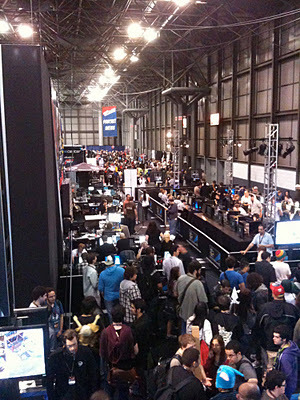
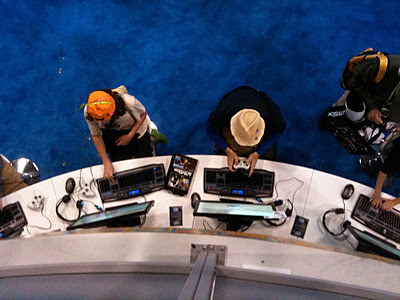 Brian is the author of Science Fiction Prototyping: Designing the Future with Science Fiction and a fascinating novel with deep roots in real science, Nebulous Mechanisms. He also is the mind behind The Tomorrow Project Anthology, a unique book of stories similarly built on a scientific foundation including works by Cory Doctorow, will.i.am, Douglass Rushkoff and Brian himself.
Brian is the author of Science Fiction Prototyping: Designing the Future with Science Fiction and a fascinating novel with deep roots in real science, Nebulous Mechanisms. He also is the mind behind The Tomorrow Project Anthology, a unique book of stories similarly built on a scientific foundation including works by Cory Doctorow, will.i.am, Douglass Rushkoff and Brian himself. Acquire these books. Read them. They will open your mind. Or explode your brain. Either way, fresh air will come rushing in….
Intel was giving away copies of the latter two books! Intel was giving away a lot of things, everything from pens to super-processors that cost big bucks. Nobody walked away empty handed.
The economic downturn apparently hasn't affected Intel because they're global and they're that good. Their prosperity shows. They had the biggest booth with the most going on. It was packed, always. Music, an outstanding MC/Host on the mic all the time directing the festivities, of which there were many…. Want to take a simulated spin in a Formula One car? Play all manner of games? What the Hell are Angry Birds anyway? Kidding. I know, I know, they're pissed off parakeets and disgruntled ducks.
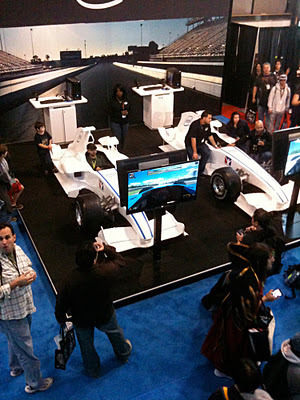 Brian and Cory had a one hour autograph session, signing free books. Intel support troops had to cap the line.
Brian and Cory had a one hour autograph session, signing free books. Intel support troops had to cap the line.JayJay, Freddy and I got to sit in the turret atop the center structure of the Intel booth with a magnificent view of the con floor while Brian and Cory signed.
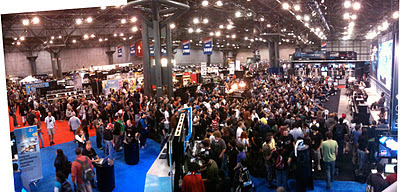 Then, Brian and I went off to the W Hotel at Union Square to meet a friend of his, Andrew Hessel, MSc. "MSc," or "Magister Scientiae." Loosely translated from the Canadian, I think, it means "Really Smart About Science Stuff."
Then, Brian and I went off to the W Hotel at Union Square to meet a friend of his, Andrew Hessel, MSc. "MSc," or "Magister Scientiae." Loosely translated from the Canadian, I think, it means "Really Smart About Science Stuff."Google him. Or start here: http://openwetware.org/wiki/Andrew_Hessel
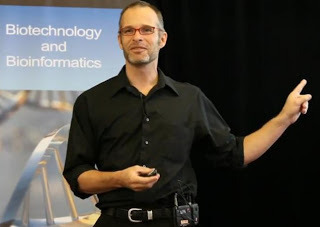 We talked about what was, what is, and what could be. They blinded me with science. I could barely keep up, and I'm good at that stuff. It helped that they're good at explaining things in English, rather than Magister Scientiae-speak.
We talked about what was, what is, and what could be. They blinded me with science. I could barely keep up, and I'm good at that stuff. It helped that they're good at explaining things in English, rather than Magister Scientiae-speak.We had dinner at a good steakhouse nearby, Angelo & Maxie's.
I have a story brewing. Not going to let all that great intel…heh, heh…go to waste. I'll let you know how it goes.
Unbelievable day. I slept like an exhausted toddler after a day at Disneyland.
NEXT: Guaranteed, Next Time for Sure, ULTIMATE COMICS – All-New Spider-Man #1 Dissected and Analyzed. No, really!
Published on October 17, 2011 11:44
October 15, 2011
October Tales: Spooky or Inexplicable Events – Part 2
Directory Assistance
Toward the end of my teen-age stint as a writer for DC Comics, I took a part-time job washing dishes at a restaurant.
It wasn't that DC wouldn't give me all the work I could handle and fill every minute of my time—the fact is that working for Mort Weisinger was killing me. His abusive keep-the-creators-under-his-thumb editorial "style" had worn me down.
Early on, when the big, important man (said he) called me from New York to yell at me about every little flaw and mistake in my latest script I felt terrible. After four years of this, I'd finally figured out that DC wouldn't keep sending me checks if what I did wasn't any good, and Mort's rants about what a moron I was for misspelling a word or some such became just noise. Grating, irritating noise. Mort still made writing comics a pain, an ordeal—even if he no longer had the ability to make me feel bad about myself.
I found myself less and less interested in the work, less and less enthused about doing something, that at first, I loved. My productivity fell off steadily.
So I looked for something, anything else to do to make some money for my family. Options are limited when you're eighteen. So, that year, and for several years after quitting DC, whenever any creative work I got wasn't steady enough, I took various less glamorous jobs.
Washing dishes at the Viking Restaurant in Banksville, just through the Fort Pitt Tunnel and down the road a ways from Pittsburgh, I met Sam, a fellow kitchen grunt. We became friends.
At one point, I needed in the worst way to make a long distance call and had no money for the pay phone. Sam gave me his last five bucks with days to go till payday. As long as I live, no matter what I ever do for Sam, there's no way I can ever repay that five bucks. You can't give more than all.
Anyway….
After a while, I noticed that the owner was shorting my paycheck. Sam showed me his. Same thing. Sam, no math whiz, probably never would have noticed.
I complained.
The owner stopped deducting non-existent taxes from my check (Pittsburgh had no city income tax), but counting on Sam's ignorance of such things, she kept screwing him.
We decided to quit. We waited till Saturday, when there was a big event in both the upstairs and downstairs party rooms, a full bar and a crowd in the main dining room. We let the dishes pile up, and when the owner came to shriek at us and demand we do the dishes, Sam flipped her his towel and said, "You do 'em." We walked out.
We celebrated by splurging on roast beef sandwiches at the Arby's down the street. Too much money to spend, really, but….
That was the last time I saw Sam for a long time.
Years later, when I was somewhat more prosperous, I was driving to West Mifflin to visit a friend and for some reason took a circuitous route through an unfamiliar part of town. I saw a Marine hitchhiking. I rarely pick up hitchhikers, but, what the hell, he was a serviceman. My daddy, having been a soldier, used to give servicemen hitchhiking a lift, if he could. So I pulled over, and the guy got in.
It was Sam! I didn't recognize him at first. Sam was the cartoon hippy last time I saw him. Now, a Marine?! Sam explained the he had joined up because they said they'd teach him how to be a baker.
Seemed to me there might be an easier way, but, okay….
His mother was sick. Very sick. He'd gotten a 24 hour pass to come and visit her.
Sam was stationed in Philadelphia, some 300 miles away. The bus ride to Pittsburgh had eaten up a third of his time. He'd have only a few hours with her at best before he'd have to catch the last possible bus back.
I drove him to his mother's house and stayed there with him so I could drive him to the bus station. To give him the maximum time home with mom.
Time came to leave for the bus. Sam couldn't do it. We stayed.
Finally, once his mother was asleep and Sam's sister was there to stay with her, we left. No way to get him to Philly except to drive him, so I did. Got him there around two AM. Late. But he climbed the fence around back, picking his way through the razor wire on top, so he wouldn't be caught AWOL.
Then I drove back to the 'Burgh and went to work at my day job—reconditioning cars at McMillen and Baer Volkswagen. That was a long, weary day….
Sam's mother died very soon thereafter. But at least he'd had a chance to say good-bye.
So, I paid off a couple cents of that five bucks….
I wonder, what are the odds that I would be driving through a strange neighborhood I had no reason being in, that I would give a lift to a serviceman on some whim driven by the fact that my father had been a soldier, and therefore trusted soldiers, and also that I had the time and wherewithal to do what I did.
Sam needed me, and there I was, however unlikely, however it came to pass.
After that, again, for a long time, Sam and I fell out of touch.
Years later, in 1976, I went through a traumatic breakup with a woman, JW, I really, truly loved. My fault. I let it slip away. When it was finally over for sure, that night I couldn't sleep. Lying awake at four o'clock in the morning, I decided to go to the office. Do some work. Try to force out the hurt by focusing on something else.
I arrived at the Marvel offices around five AM, as opposed to my usual 7 or 7:30. For some reason, I sat down at a desk out in the big editorial room, rather than in my own office. The phone on the desk I had randomly chosen rang.
If you called Marvel in 1976, you reached the reception desk. At 5 AM, with no receptionist present, you would have gotten no answer. You could dial a staffer directly, if you knew the extension.
So who was calling the person at whose desk I was sitting at that hour?
I answered.
It was Sam.
Sam was out of the Marines by then and worked at a bakery in Tulsa. I asked him what made him call at 5 AM. Well, he said, he'd just gotten done making the donuts and was thinking about me, so he gave me a call.
But it's 5 AM, I said. How did you know…? What made you think I'd be at work? For that matter, how did you know I worked at Marvel Comics?!
There was no way he could even have known I'd moved to New York!
Sam had no idea it was 5 AM my time. I don't think he knew or cared much about time zones. He knew I wrote comics, so he called Marvel. Is there some other kind, he asked? He didn't know Marvel was in New York. Anyway, he thought he'd call, and, sure enough, I was there, right? So…what's wrong with being right?
I asked him where he got the number he'd called. Directory assistance, he said. He didn't have anything to write it down with, and he was afraid he'd screw up dialing it, but nope.
Directory assistance would give you Marvel's main number, I said. How did he get this particular extension? "I don't know," said Sam.
So, he asked me what was wrong. Not, what's doin', not how are you. What's wrong? I told him.
Sam may be math challenged, and he might not grok time zones, and he thought joining the Marines might be a good way to learn how to be a baker, but in a very fundamental, common sense way, he's the wisest man I've ever known. After listening to my sad tale he said these words: "She didn't love you enough."
Well…all righty, then, there it is, isn't it?
It didn't make it all better, but…it sure gave me a new perspective. True. And better to find that out sooner rather than later. The first step to getting over JW.
So we talked for a while, promised to call each other and maybe visit sometime. Never happened for one reason or another.
I needed Sam, and there he was, however unlikely, however it came to pass.
It's weirder than you think. I scoured the place after I hung up, to make sure no one else was there who might have answered the receptionist's phone, known somehow which extension I was near and transferred the call. Nope. Nobody there but me.
Furthermore, Marvel Comics extensions had a different exchange than the main number. I don't know why, but apparently that wasn't an uncommon thing back then. So, the number directory assistance gave Sam was off by the three exchange digits as well as the four numbers that followed. All he got that was right was the area code.
I looked Marvel's number up in the Manhattan directory just to be sure that the number Sam called wasn't there for unfathomable reasons. Nope. I called directory assistance myself to see what numbers for Marvel were available. Only the main number.
And, oh, by the way, not that it made any difference, but there was a one-digit error in Marvel's number in the phone book! A misprint! The book and directory assistance gave you a non-working number! Call that number (I did) and you got that screechy "We're sorry, the call you made cannot be completed as dialed."
I reported that to the financial guy who oversaw HR and other office management functions. Apparently, no one had ever checked.
I haven't heard from Sam since.
As I said at the beginning of this personal X-Files series, I stated that I don't believe in anything the existence of which has not been proven to my satisfaction. Not miracles, not ESP, not magic, not flying saucers, not ghosts….
And yet…some irrepressible notion in the back of my mind tells me that if, someday, Sam really needed me or I really needed him, there I'd be or there he'd be.
Absolutely true story.
My Girlfriend's Dead Aunt Comes to Call
It happened one October night years later, 1992, to be exact. My girlfriend, let's call her SF, and I were staying at her place. Sometime in the wee hours, we both suddenly, simultaneously woke up.
There was silence.
Then we heard someone in the hall outside the bedroom.
SF kept the bedroom door closed out of habit, left over from when she had an apartment mate in the second bedroom. The door latch, however, was broken, the legacy of a violent boyfriend who had once tried to kick in the sturdy, metal door to get at her, but only succeeded in damaging the latch hardware and hurting his foot. Good. Anyway, the door closed, but the taped-over latchbolt no longer held it closed. Push the door and it opened.
Ordinarily, adrenaline carries me to a state of fearlessness or extreme stupidity, depending on your point of view. Ordinarily, I would have quickly found a heavy item to hit with and gone to find out who or what the hell was out there. But this time, though my heart was pounding, I was frozen.
Irrationally afraid. So was SF.
We were clinging to each other like scared little kids.
The door swung open. A little light came in from the lights outside illuminating the apartment complex grounds. We could see that there was no one at the door.
But it felt like there was. Hard to explain, seeing nothing but knowing that someone or something is there.
The someone or something moved to the foot of the bed. Walked to the foot of the bed. We tracked its progress step by slow step in unison.
It stood there for what seemed like forever, but was probably only seconds.
Then it was gone. And, just like that we were no longer afraid. More than relieved, in fact. Comforted. We quickly went back to sleep.
In the morning, SF told me that two years earlier, on that very day, she and her boyfriend at the time had gone to visit her aunt, who also lived in Manhattan, and found her dead.
The aunt never liked that boyfriend.
SF told me that a year earlier on the anniversary of her aunt's death, she had also awakened suddenly during the night and felt scared. It passed quickly. She was alone at the time.
She thought it was her aunt checking up on the kind of company she was keeping.
I guess I passed muster. I wonder what would have happened if I hadn't.
MONDAY: ULTIMATE COMICS – All-New Spider-Man #1 Dissected and Analyzed
Published on October 15, 2011 15:22
October 14, 2011
Science Fiction vs. Science Fantasy
Defiant1 Commented:
Answer:
RE: Science fiction vs. science fantasy: Some of us are still trying to go the science fiction route. An executive from Intel whose title is "Futurist" was sufficiently impressed by the research and real science underlying the stories my recent Doctor Solar: Man of the Atom and Magnus Robot Fighter comics that he based a lecture he gave at the University of Washington on my stories. He also invited me to appear with him and Craig Engler, senior executive of the SyFy Channel on a panel this Sunday at the NYCC: "Screen Future: Gaming, Comics and TV Around the World and Five Years From Now."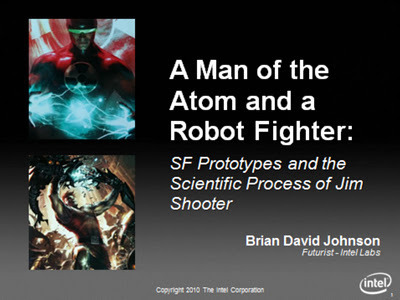

"I think it's funny seeing Matt Murdock say "It was nice of Foggy to get me this push button tape recorder". That would have been a big deal to a kid back then. My dad let me play with one he owned in the 70's and I know I played with it for hours upon hours. The one pictured above looks like it's about 3 times as big as the one I used.
One thing that bothers me about modern comics is that in many cases they are still using repulsor rays and outdated or misinterpreted science from 50 years ago. When Stan Lee wrote about transistors in 1961, they had only been invented 2 years earlier. Stan didn't understand that transistors don't actually power anything, because they were just a switch.... What's important to me is that he made an attempt to keep the science and technology relevant. I don't see any interest by most writers to do that in modern comics. We have scientists on the verge of creating black holes in Europe. We've got robots that climb walls using nothing but surface tension. We have scientists out in Arizona melting diamonds and creating heat 60 times hotter than the sun. I liked comics for the imagination and possibilities they introduced. Definitely not just social possibilities they showed us. There was more to it than "Hey, I'm bigger than you... I'll stick my chest out while I'm hitting you into the next state."
People are working on Iron Man armors. People are working on suits you can wear to climb walls like Spider-Man. Scientists are working on Invisibility cloaks that can hide objects or entire events. Scientists have made a material 10 times harder than diamonds. Is it any wonder kids have no interest in science related occupations anymore. Mainstream modern literature escapes more into pure science-fantasy than it does science-fiction.
Apologies for derailing the topic, but those images mean more to me than just examples of female stereotypes in the 60's and 70's."
Answer:
RE: Science fiction vs. science fantasy: Some of us are still trying to go the science fiction route. An executive from Intel whose title is "Futurist" was sufficiently impressed by the research and real science underlying the stories my recent Doctor Solar: Man of the Atom and Magnus Robot Fighter comics that he based a lecture he gave at the University of Washington on my stories. He also invited me to appear with him and Craig Engler, senior executive of the SyFy Channel on a panel this Sunday at the NYCC: "Screen Future: Gaming, Comics and TV Around the World and Five Years From Now."

Published on October 14, 2011 19:28
A Question About Female Characters
Question: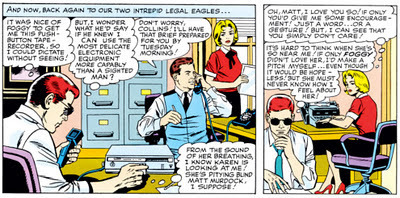 Answer:
Answer:
RE: the portrayal of female characters in the 1960's and 1970's. Those were less enlightened times. And not all the creators at that time were up to date even with the current state of enlightenment.
I grew up in the 50's and 60's. That was a remarkable time in which a sweeping revolution began that has changed the world, at least the western world, tremendously. It didn't happen suddenly, all at once, but starting then and continuing now a revolution in the human condition occurred. I was just old enough to retain an awareness of the before and comprehend the transition into the after, up to the present. Therefore, I am able to conceive of and believe in progress beyond the still-sorry state of things.
The world of my early childhood was to a great degree, like the world of my parents' early lives, the 30's and 40's. The world of my teens and thereafter is the new world that developed in fits and starts, lurching and meandering toward where we are now.
[image error] As the situation in real life evolved, so too did the presentation of female characters in fiction. But there was a lag time. Older creators especially seemed to be slow to embrace enlightenment. To some extent, I give those who grew up entirely on the other side of the watershed a "senior citizen discount." Taught throughout early life various prejudices, or, more accurately false "truths," it was harder on them to open their eyes. I don't give them a pass, but I'm more patient with them.
 Some creators responded to the comic book business's slowness to change by emphasizing female characters. Chris Claremont, for instance, routinely made airline pilots female. I asked Chris to throw in a male pilot once just to show that it could happen. : ) P.S. During the early 1980's, according to an article in an in-flight magazine I read on a British Airways flight, in the entire world, there was only one female pilot flying a regular route for major airline: a London/Africa route, as I recall, for B. A.
Some creators responded to the comic book business's slowness to change by emphasizing female characters. Chris Claremont, for instance, routinely made airline pilots female. I asked Chris to throw in a male pilot once just to show that it could happen. : ) P.S. During the early 1980's, according to an article in an in-flight magazine I read on a British Airways flight, in the entire world, there was only one female pilot flying a regular route for major airline: a London/Africa route, as I recall, for B. A.
Some creators similarly intent on featuring female characters in what would have been considered male roles earlier frequently introduced female police chiefs, doctors and CEOs -- though, too many times, they just couldn't stop themselves from dressing said women in high-slit skirts and fishnets.
My own approach is to try to present reality reasonably recognizably but allow no prejudices to cripple me with regard to the human beings -- and androids, gods, mutants, aliens, etc. : ) -- who populate my stories. Also, not to present ciphers -- even the toughest person can have a moment of weakness or despair. Even a "limp" person can rise up and show inner strength. I look at the people around me, I look at myself and I try to express the human condition as well as I can. Because often I am writing about heroic characters, and people facing extraordinary challenges, I am often privileged to write about the best parts of the human spirit. And the worst, by the way.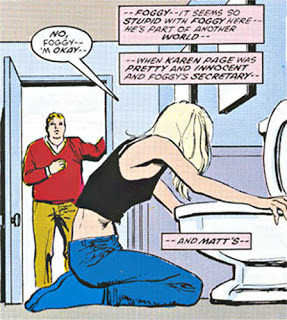 Karen Page, created in the early '60's, started out as a beautiful, smart young woman, but as you say, an "Oh, Matt...." type. That persisted for quite a while, maybe until Frank Miller came along, and whatever you may think of how he handled the character, she certainly was no longer the 2-D cipher she had been.
Karen Page, created in the early '60's, started out as a beautiful, smart young woman, but as you say, an "Oh, Matt...." type. That persisted for quite a while, maybe until Frank Miller came along, and whatever you may think of how he handled the character, she certainly was no longer the 2-D cipher she had been.
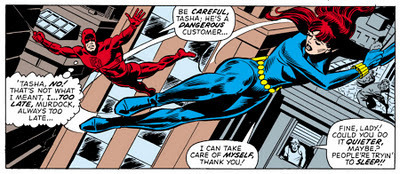
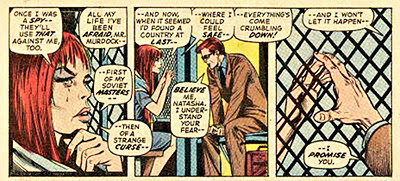 The Black Widow started out as a super-spy, and aside from a rare weak moment -- see above -- and shouldn't have been "limp" even back in ancient days.
The Black Widow started out as a super-spy, and aside from a rare weak moment -- see above -- and shouldn't have been "limp" even back in ancient days.
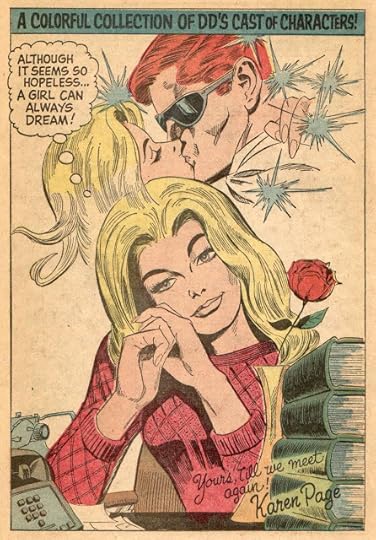

"Totally off-topic, I've been reading some old Daredevil tales from the 1960s/70s and was surprised at the "limp" way the female characters were presented. Both Karen Page (in particular) and the Black Widow are from the "Oh, Matt..." school. Any thoughts? (or kick me into the place where I SHOULD have posted this) - MmM "
 Answer:
Answer:RE: the portrayal of female characters in the 1960's and 1970's. Those were less enlightened times. And not all the creators at that time were up to date even with the current state of enlightenment.
I grew up in the 50's and 60's. That was a remarkable time in which a sweeping revolution began that has changed the world, at least the western world, tremendously. It didn't happen suddenly, all at once, but starting then and continuing now a revolution in the human condition occurred. I was just old enough to retain an awareness of the before and comprehend the transition into the after, up to the present. Therefore, I am able to conceive of and believe in progress beyond the still-sorry state of things.
The world of my early childhood was to a great degree, like the world of my parents' early lives, the 30's and 40's. The world of my teens and thereafter is the new world that developed in fits and starts, lurching and meandering toward where we are now.
[image error] As the situation in real life evolved, so too did the presentation of female characters in fiction. But there was a lag time. Older creators especially seemed to be slow to embrace enlightenment. To some extent, I give those who grew up entirely on the other side of the watershed a "senior citizen discount." Taught throughout early life various prejudices, or, more accurately false "truths," it was harder on them to open their eyes. I don't give them a pass, but I'm more patient with them.
 Some creators responded to the comic book business's slowness to change by emphasizing female characters. Chris Claremont, for instance, routinely made airline pilots female. I asked Chris to throw in a male pilot once just to show that it could happen. : ) P.S. During the early 1980's, according to an article in an in-flight magazine I read on a British Airways flight, in the entire world, there was only one female pilot flying a regular route for major airline: a London/Africa route, as I recall, for B. A.
Some creators responded to the comic book business's slowness to change by emphasizing female characters. Chris Claremont, for instance, routinely made airline pilots female. I asked Chris to throw in a male pilot once just to show that it could happen. : ) P.S. During the early 1980's, according to an article in an in-flight magazine I read on a British Airways flight, in the entire world, there was only one female pilot flying a regular route for major airline: a London/Africa route, as I recall, for B. A.Some creators similarly intent on featuring female characters in what would have been considered male roles earlier frequently introduced female police chiefs, doctors and CEOs -- though, too many times, they just couldn't stop themselves from dressing said women in high-slit skirts and fishnets.
My own approach is to try to present reality reasonably recognizably but allow no prejudices to cripple me with regard to the human beings -- and androids, gods, mutants, aliens, etc. : ) -- who populate my stories. Also, not to present ciphers -- even the toughest person can have a moment of weakness or despair. Even a "limp" person can rise up and show inner strength. I look at the people around me, I look at myself and I try to express the human condition as well as I can. Because often I am writing about heroic characters, and people facing extraordinary challenges, I am often privileged to write about the best parts of the human spirit. And the worst, by the way.
 Karen Page, created in the early '60's, started out as a beautiful, smart young woman, but as you say, an "Oh, Matt...." type. That persisted for quite a while, maybe until Frank Miller came along, and whatever you may think of how he handled the character, she certainly was no longer the 2-D cipher she had been.
Karen Page, created in the early '60's, started out as a beautiful, smart young woman, but as you say, an "Oh, Matt...." type. That persisted for quite a while, maybe until Frank Miller came along, and whatever you may think of how he handled the character, she certainly was no longer the 2-D cipher she had been.

 The Black Widow started out as a super-spy, and aside from a rare weak moment -- see above -- and shouldn't have been "limp" even back in ancient days.
The Black Widow started out as a super-spy, and aside from a rare weak moment -- see above -- and shouldn't have been "limp" even back in ancient days.

Published on October 14, 2011 10:21
Jim Shooter's Blog
- Jim Shooter's profile
- 85 followers
Jim Shooter isn't a Goodreads Author
(yet),
but they
do have a blog,
so here are some recent posts imported from
their feed.



